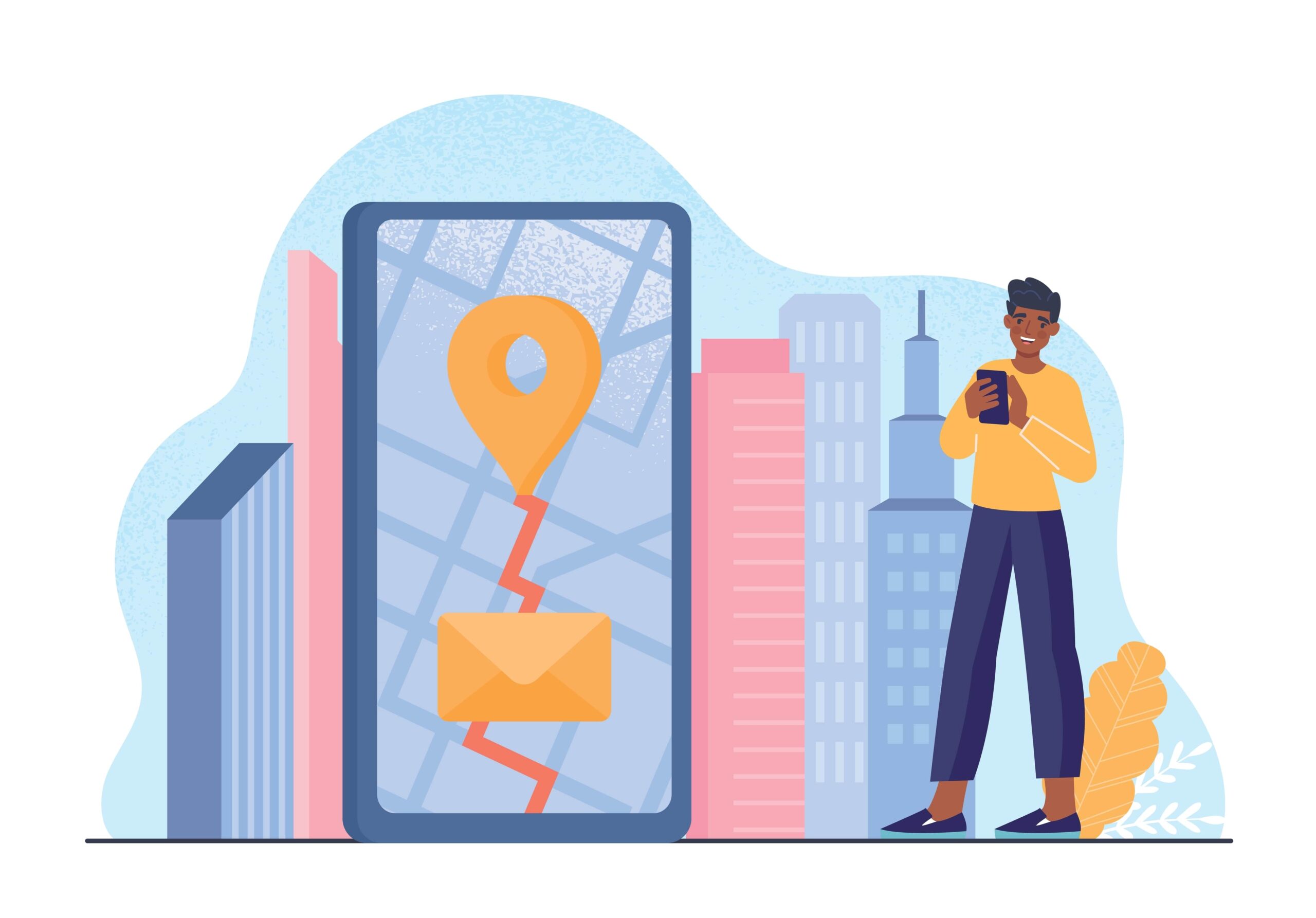Are you satisfied with earning a single sale from every customer? Or do you dream bigger? Increasing customer lifetime values and lowering customer acquisition costs is no fairy tale. All it takes is a full-funnel or lifecycle approach that continues your customer conversations beyond that first conversion. Post-purchase emails are a cost-effective way to keep more customers and increase brand loyalty. Want to know how it’s done? This is the article for you.
Every business has to start somewhere.
A single sale, a few early customers, a small selection of products, or an MVP that grows into something more over time.
What’s the secret to that growth?
How is it that some businesses seem to snowball–getting bigger and more widely known–while others just muddle along?
Generating demand, acquiring leads, and converting them to customers are all essential to these companies’ success, of course.
But there’s more to it than that.
High-growth companies use relationship marketing strategies to squeeze returns from every stage in the buyer’s journey. And they make sure their customer relationships last as long as possible.
Sustaining customer relationships that last beyond the first conversion requires a full customer lifecycle marketing strategy that maintains your brand’s connection with your customers, ensures their satisfaction, nurtures further purchases, and, at maximum yield, converts them to brand advocates.
I’m a big fan of growth marketing because it enables brands to reap the full benefits of their marketing efforts and it focuses on delivering real value to both brands and their customers.
These after-conversion campaigns build on the success of your customer acquisition efforts and magnify them with lasting customer relationships, higher customer lifetime values, and increased brand loyalty.
This is how modern businesses survive and thrive.
It reminds me of the three little pigs fable.
You remember the one where each little piggy built a house, one of straw, another of sticks, and the third of bricks. Then when the big bad wolf came around, only the brick house was sturdy enough to protect them.
I know there are a lot of different versions of this story.
In some versions, only one of the little pigs is wise and diligent while the others rushed to build shelters that were flimsy and inadequate–one of straw and the other of sticks.
In other versions, impatience wasn’t the issue, it was a matter of funds. The straw and stick piggies had spent their money foolishly and couldn’t afford bricks.
I like to think that the situation was more like those of most new businesses.
Those little piggies had to start somewhere! 🐷🐷🐷
I think they were working and building together all along. Think about it. Where was that third piggy living while they were building their brick house?
The first built their house of straw because it was fast and affordable. But then, the piggies had a little shelter, gained experience, and maybe earned some more money so they could invest in sticks.
Now they’ve got stability.
Now they can invest in maximizing their ROI by buying bricks and building a house made to withstand the big, bad wolf (or increasing ad costs, inflation, whatever). 🧱
Be like the piggies. Don’t be content with single-sale straws or new customer sticks. Go for the brick house–repeat sales from loyal customers.
I’m going to show you how to use post-purchase emails at every after-acquisition stage of your buyer’s journey to build your brick house right now.
What are post-purchase emails?
Post-purchase emails are email messages sent to someone who has become a customer of your business.
Businesses prepare post-purchase emails in advance, crafting automated single messages or email workflows to respond to designated customer behaviors or conversion events.
The trigger for initiating a post-purchase email sequence could be placing an order, subscribing to a service, or taking some other action that the sender defines as a purchase.
Both transactional and promotional content may appear in a post-purchase email, and not every post-purchase communication is triggered by what we traditionally consider a purchase.
Information or digital product purchase emails will differ from physical product post-purchase campaigns. Further, conversion events such as a free subscription or trial sign-up may trigger a post-conversion sequence similar to a post-purchase campaign.
In most instances, post-purchase communications with your customers should include more than one email message.
The first communication should confirm receipt of the customer’s order and thank them, while subsequent messages update the customer on the status of their order, ensure their satisfaction and nurture their ongoing relationship with the seller.
Why are post-purchase emails important?
Post-purchase emails serve your customers by keeping them in the loop and up-to-date on their purchases. These messages also serve your business by ensuring that you deliver a quality customer experience and offering you an opportunity to expand your revenue.
5 unbeatable benefits of post-purchase emails:
|
Post-purchase emails improve customer experiences and satisfaction
Transactional messages confirming the order’s receipt provide customers with important information and assurances. These and other follow-up emails ensure that your customers’ after-purchase experience goes smoothly and they are happy with their purchase.
Order confirmation emails, in particular, are an expected communication following an online purchase. Without confirmation that they successfully completed their transaction, your customers may think they need to shop elsewhere to make sure they get what they want.
Similarly, shipping and delivery updates keep your customers informed and prevent them from feeling insecure about their order status. Shipping and delivery updates also help your customers avoid theft–which helps you avoid negotiating responsibility for missing packages.
📊 85% of consumers will drop a retailer after a poor delivery experience, and 28% say tracking and visibility are important to that experience.
Your post-purchase emails are also an opportunity to improve your customer’s experiences by making them feel valued and appreciated by you and confident about their decision.
Onboarding emails that explain how to make the most from their purchase, choice-affirming social proof, and community connections that fuel a sense of belongingness all fuel improved customer satisfaction.
👀 Check out our complete guide for onboarding emails to learn how to create amazing onboarding sequences and view examples of onboarding emails from other brands.
Why does post-purchase affirmation matter?
Because of post-purchase dissonance (a.k.a. buyer’s remorse).
What is post-purchase dissonance?
Buyer’s remorse, post-purchase dissonance, or after-sale anxiety happens when someone makes a purchase, then begins to doubt their decision.
Buyer’s remorse may also occur when someone feels that they overpaid for a product or when they’ve made an impulse purchase. When a purchase doesn’t deliver the anticipated after-sale uplift or the good feeling doesn’t last, a customer may feel post-purchase dissonance as well.
Ethical or values-based concerns about the product or the business selling it can also cause someone to feel anxious about their decision to buy.
For online sellers of physical goods, a lack of instant gratification amplifies the risks of remorse. Your customers have time between purchase and delivery to contemplate and reconsider their choice.
You can use post-purchase transactional and marketing emails to help ease your customers’ internal conflict with encouraging messages that offer reassurance that they made the right decision.
This reassurance may come in the form of social proof, such as customer testimonials and use cases.
Associating the purchase with a feeling of belongingness through social media or community forums and sharing your brand’s values in your follow-up communications can help prevent buyer’s remorse, too. Educational content that reinforces your product’s value can reduce post-purchase price anxieties.
Post-purchase email sequences facilitate successful adoption and reduce churn
Another purpose (and benefit) of post-purchase emails is to support customer adoption and success. Just because someone buys an item doesn’t mean they will use it. And just because someone uses an item doesn’t mean they’ll use it correctly or want to purchase it again.
Post-purchase emails can increase product or service adoption and use and customer retention rates (reducing customer churn) by ensuring that every customer understands how to extract the most value from their purchase.
Additionally, these emails can help brands identify and address post-purchase concerns. Use automated post-purchase email flows to offer assistance and request feedback to prevent negative experiences and negative reviews.
Helping your customers understand and experience your products’ or services’ value can prevent returns or cancellations, too. Reverse logistics is becoming an increasingly expensive problem for retailers.
📊 Returns cost online retailers an average of 21% of order value. The estimated return rate for online sellers ranges from 16.5%to 26.5% of total online spending.
Maintaining communication after the first sale extends customer relationships and increases customer lifetime values
Keeping the customers you’ve worked so hard to get improves your business’s ROI. Whether you call it the flywheel effect, growth marketing, or the pirate metrics framework (the AARRR funnel), maximizing the value of every customer relationship maximizes your ROI.
Many brands find that retaining existing customers costs less than acquiring new ones.
If your existing customers purchase at the same rate, this retention vs. acquisition savings becomes cost-per-conversion savings. Further, existing customers are often more likely to try new products or purchase more items per transaction (increasing your average order values).
Of course, the longer someone remains a customer and continues to make purchases, the higher their lifetime value becomes, too.
Finally, when a customer becomes a brand advocate, they become a source of new leads which reduces your overall customer acquisition costs.
Boom!
All of these are reasons to maintain the momentum following a sale with post-purchase email nurturing.
What types of post-purchase emails should you send?
Post-purchase emails may be transactional or marketing emails, or a combination of both. The types of emails you choose to send to a specific customer will depend on the permissions they’ve granted and applicable privacy laws, as well as their stage in their buyer’s journey and your objectives.
Starting with their first purchase or subscription, the types of email you can send to customers after their purchase include:
Post-purchase transactional emails
- Purchase confirmations and acknowledgments, including orders, pre-orders, subscriptions, registrations, or reservations. (Always accompany this with a thank you.)
- Order preparation notices, including status updates, out-of-stock or substitution notifications, and other pre-shipping updates.
- Shipping notifications and status updates.
- Delivery estimates and post-delivery notifications.
- Receipts and status updates for returns.
- Repeat billing or renewal notices.
Post-purchase marketing emails
- Double opt-in or subscription confirmations for customers who subscribed to your brand’s newsletter during the purchase process.
- A first welcome and thank you message.
- Onboarding sequences to facilitate the adoption and use of your product or service. The onboarding series may include tutorials, feature highlights or tool tips, how-to or product use guides, and other customer success content.
- Emails requesting customer preferences and other information. These messages may include in-email interactive content or direct the recipient to your website’s preference center.
- Customer success and satisfaction check-ins such as onboarding and use nudges, feedback requests, surprise and delight content that entertains or adds unexpected value, or retargeting and retention campaigns.
- Post-purchase promotions aimed at upsells, resells, and cross-sells. This category includes both targeted and non-targeted promotions, product announcements, discounts and other offers, replenishment and renewal reminders, rewards or VIP program invitations and updates, and recommendations emails.
- Relationship-building email campaigns that share community or brand news, express shared values and support common causes, or provide educational content about your brand or its products.
- Emails that encourage brand advocacy. Campaigns that invite subscribers to share their product images or other user-generated content, give a product review, rating or testimonials or refer your products or services to others fall within this category.
- Reengagement, reactivation, or winback campaigns. Messages to recover lapsed customers may successfully win them back, increasing their customer lifetime value.
Do you have to get permission before sending post-purchase marketing content to a customer?
When a new customer isn’t a subscriber, you should attempt to convert them to an email subscriber as well.
The fact that someone has purchased a product or service from your business doesn’t mean that they have consented to receive marketing emails from you, and some jurisdictions require explicit consent separate from the transaction before you can send marketing content to a consumer.
Gaining consent before sending marketing emails keeps you in compliance with data privacy and anti-spam laws and demonstrates your commitment to respecting customers’ control of their data (and inboxes).
Among the applicable laws defining when you must have implicit or explicit consent to send marketing messages to people are the EU’s General Data Protection Regulation (GDPR), Canada’s Anti-Spam Law (CASL), the US Controlling the Assault of Non-Solicited Pornography And Marketing Act of 2003 (CAN-SPAM Act) and the California Privacy Rights Act (CPRA).
⚠️ Keep your legal knowledge updated. Various countries and US states have and continue to issue new legislation on this topic.
Get explicit consent to send customers marketing content by asking them to subscribe to your list at checkout. Don’t require that purchases opt-in for non-transactional messages as a condition of their purchase. This may cause them to abandon the checkout process, and obtaining non-optional opt-ins isn’t what permission-based marketing is about.
Once you have consent, you can begin sending post-purchase marketing emails to these new customer-subscribers. In most instances, though, your first post-purchase contacts will be transactional emails that acknowledge your customers’ purchases.
45 real-world examples of post-purchase emails from MOFU to BOFU and how to write your own
Meet your email recipients with the right message for their stage in the buyer’s journey by preparing a series of post-purchase templates that include both transactional and marketing emails.
Use the following instructions and examples to build your own template library of after-sales emails to keep your customers informed, invested, engaged, and returning.
Use post-purchase emails to say “thank you,” confirm customers’ purchases, and provide delivery and other status updates
Whether someone previously subscribed to your email list or is a completely new contact, the post-purchase order confirmation and thank you email represents the kickoff of a new relationship.
This is the message you send after that first critical conversion, and it should always include a transactional acknowledgment and thank you.
Confirming someone’s order as soon as possible (and thanking them) is an important step toward ensuring their satisfaction with their purchase experience.
Send a confirmation email immediately after your customer places their order. Depending on how closely your inventory system is integrated with your email automations, this first email may be primarily an acknowledgment and thank you with more details to follow.
Use merge tags to integrate dynamic content and present as much information as possible in your initial confirmation message. Then send your customer updates as additional details about their order become available.
What information should a purchase or order confirmation or shipping and delivery notice include?
- An order identification number to facilitate tracking and communication about the purchase.
- The date the order was placed and its current status. A real- or almost-real-time visual element such as a timeline or chart can make your message more user-friendly and engaging.
- Shipping and delivery details, including the shipping method and, if available, estimated delivery date and tracking link.
- The customer’s contact details so they can confirm their accuracy.
- Billing information, including the method of payment, name of payor, and billing address.
- The shipping address for items that will be physically delivered.
- A summary of the items or services included in the order. Details may include item SKU, volume or quantity for physical items and duration for subscription orders, color, size or other specifications, item unit prices, and total price.
- A link to their order account page.
- A breakdown of additional costs or fees, such as shipping costs and taxes.
- A statement of and/or link to your company’s return policy.
- Your organization’s contact information. Place your standard contact information in your email footer, so it is easy to locate.
- A message thanking your customer for their purchase.
Along with stating your appreciation, include helpful links and contact information throughout the email body where appropriate and encourage customers to follow–up with any questions or concerns.
Even if you cannot include marketing content in your confirmation message, you can still use it as a vehicle to make a great impression on customers through positive, customer-first copy.
Follow similar practices when sending shipping and delivery updates to your customers. Keep them in the loop with timely, accurate information and helpful links that empower them to track their orders and get additional information.
These examples from the Ongage Team’s inboxes illustrate the ways in which brands keep their customers informed after an order is placed.
📧 Order confirmation: Lego sends a cheery greeting to purchasers.
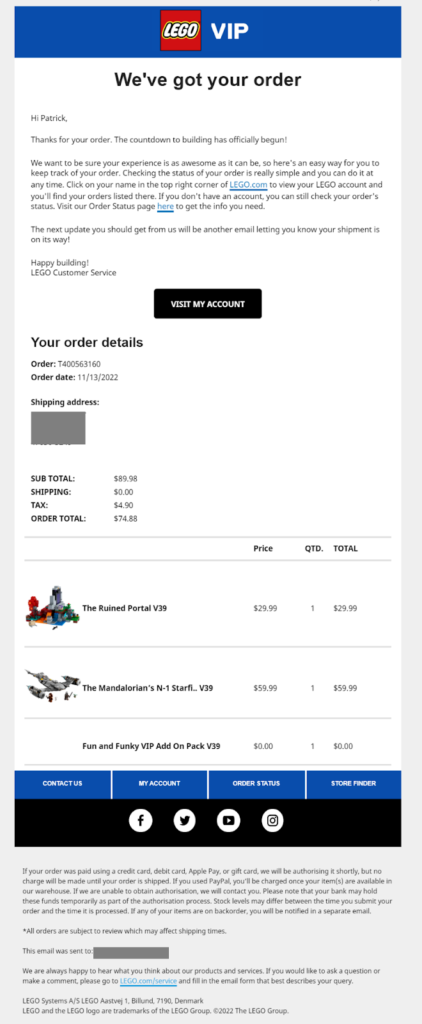
📨 We’ve got it! Your LEGO® order is confirmed {{First_Name}} – We got your order.
Lego’s order confirmation email maintains the brand’s tone of voice throughout, opening with a personalized greeting followed by copy that says,
“Thanks for your order. The countdown to building has officially begun! We want to be sure your experience is as awesome as it can be, so here’s an essay way for you to keep track of your order.”

The templated copy includes detailed instructions for how the purchaser can access their account and a link to the website, plus a direct (customized) link to their Order Status Page.
If that information wasn’t easy enough to spot, there’s also a high-contrast “Visit My Account” button.
Following this information, the email includes details about the items purchased, complete with images. This customized copy is made possible through the use of a dynamic block in the email template that feeds directly from the Lego order fulfillment system.
We explain how to customize individual and mass emails using dynamic files and blocks in the article, Dynamic Email Content: How to Apply and Use It at Scale.
📧 Online subscription confirmation: The New York Times sends order and renewal details to new subscribers.
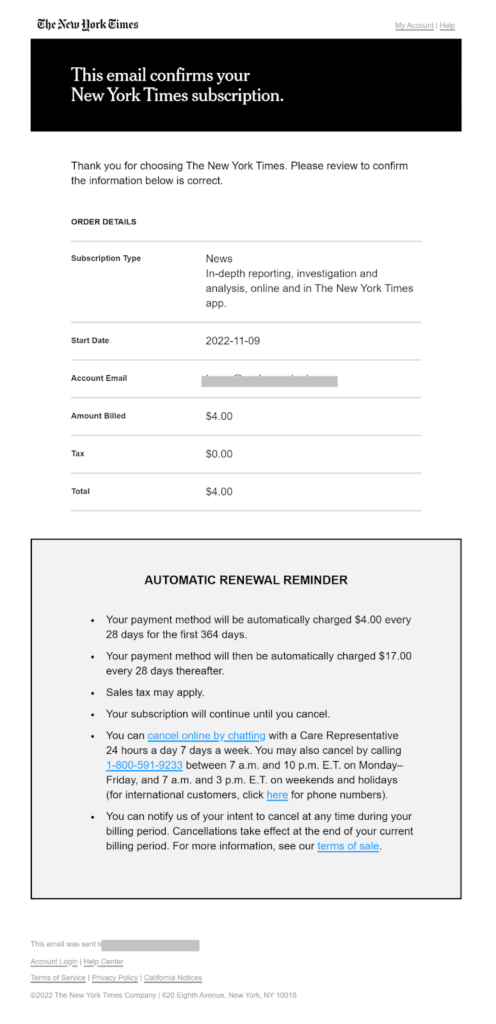
📨 NYTimes Digital Subscription Order Confirmatiion – The New York Times
This confirmation email includes a customized section that details the individual purchaser’s subscription and asks them to confirm that the information is correct.
The email also promotes the publisher’s brand message. Next to the category “subscription type,” the text says,
News In-depth reporting, investigation and analysis, online and in The New York Times app.
A separate block includes the terms of the automatic renewal policy that The New York Times encourages new subscribers to enroll in, along with instructions for canceling auto-renewals and accompanying links.
This confirmation template presents a good example of transactional transparency.
Failing to disclose the terms of your purchase agreement or making it difficult for customers to cancel subscriptions may seem like a way to keep the revenue coming, but the real returns are negative customer experiences.
📧 Digital product account creation: Ranktracker keeps it simple with a one-click confirmation.
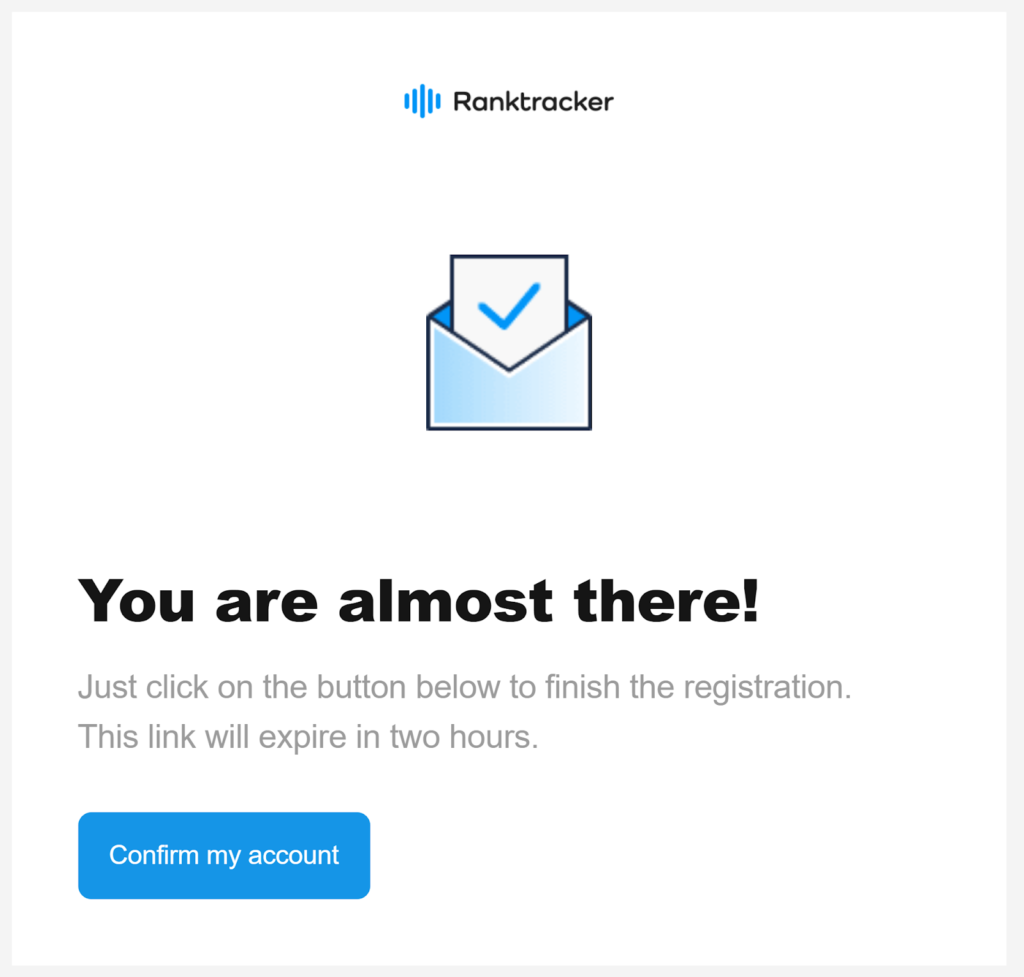
📨 Ranktracker Account Creation
This simple autoresponder enables Ranktracker, a digital SEO app provider, to ensure that it’s communicating with the correct email address when setting up a new account.
Spambots sometimes attempt to register fake emails with organizations to gather data or invade systems. Confirming that new account sign-ups are from real people helps protect the integrity of your email lists.
📧 Ready-to-ship notification: Target sends an enthusiastic update once an order is packaged and ready to leave the fulfillment center.

📨 Get ready for something special! Order #{{order id}} is about to ship. – we packed your order with extra care, and it’ll be headed your way soon.
Target alerts customers when their order has been fulfilled and is ready to ship with an update featuring the brand mascot.
The hero image, along with a personalized heading and templated subheading, saying,
“{{First_Name}}, your order is ready to ship! Oh boy (oh boy oh boy),”
set a positive tone for the message.

As both an online and bricks and mortar retailer, Target has a convenient local returns policy. The details of this email include a link to the customer’s order page and a QR code they can scan if they wish to make an in-store return.
Include friction-reducing details in each of your transactional emails so your customers don’t have to hunt for information when they need it.
📧 Order has shipped notification email: Puritan’s Pride sends a user-friendly update and tracking code for shipped items.

📨 Your Order Has Shipped (Order {{Order ID}} )
This customized shipping notice from Puritan’s Pride incorporates personalized order details Including product information and a shipment tracking code into an attractive template that provides recipients with key information and policies, along with links to pages where they can find more information.

An interactive timeline provides a visual representation of the order’s progress that updates in real–time. The email was sent on January 6, while the package was in transit. But we captured the images for this email example after the order had safely arrived (on January 11).
📧 Out of stock (OOS) notification: Enjoy Life alerts customers to problems using a customizable template.
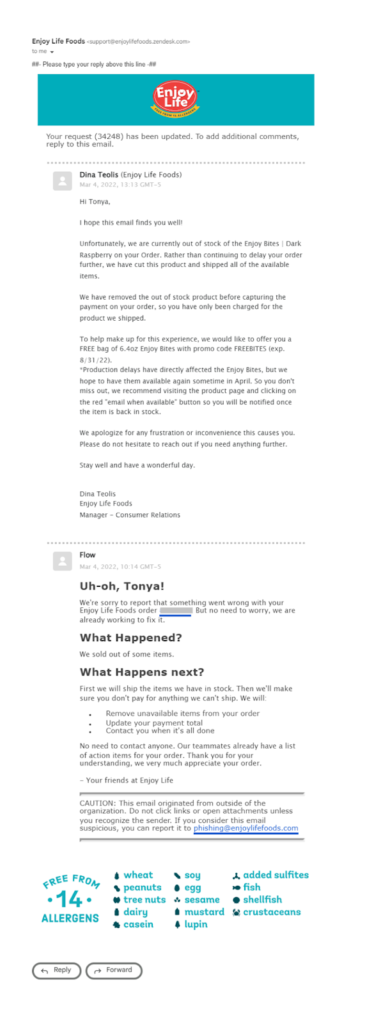
📨 [Enjoy Life Foods] Re: OOS Notification, Item(s) Removed from Order (186687) – {{First_Name Last_Name}} – Mar 2022
Enjoy Life uses an automated template with a dynamic “problem” field to alert customers when something has gone wrong with their order.
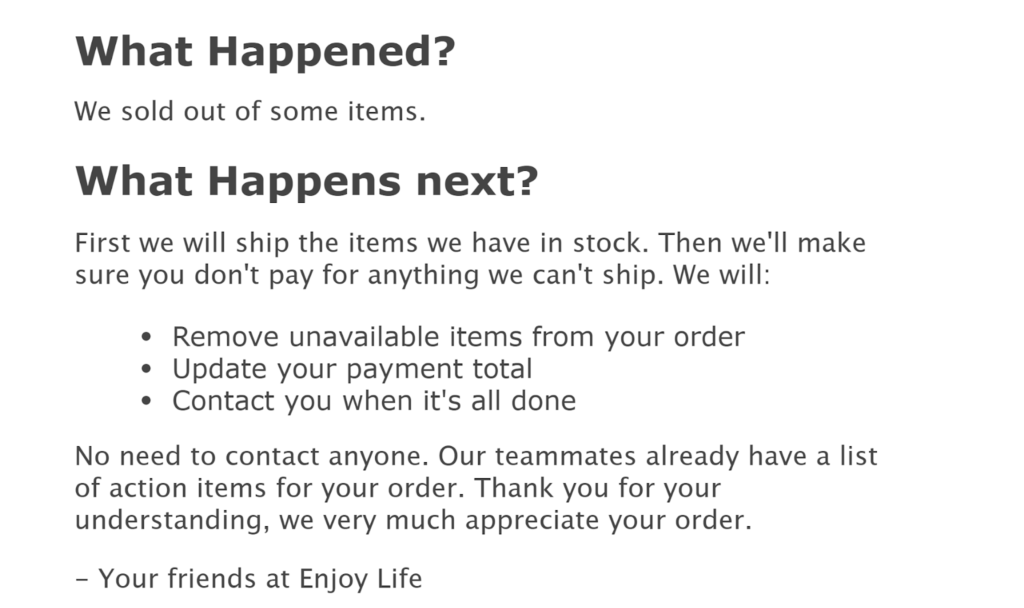
This template also includes standard text that anticipates and answers customers’ FAQs, using the following copy:
“What happens next? First we will ship the items we have in stock. Then we’ll make sure you don’t pay for anything we can’t ship. We will:
- Remove unavailable items from your order
- Update your payment total
- Contact you when it’s all done
No need to contact anyone. Our teammates already have a list of action items for your order…”
A customized update from an Enjoy Life team member accompanied this message explaining more about which item was out of stock and providing a code for a free product.
Post-purchase customer service emails acknowledging and apologizing for problems and proactively explaining what will happen next will reduce the number of customer service calls your team members have to field.
📧 Status update for a digital service: H&R Block keeps customers informed about their filing status through post-purchase emails.
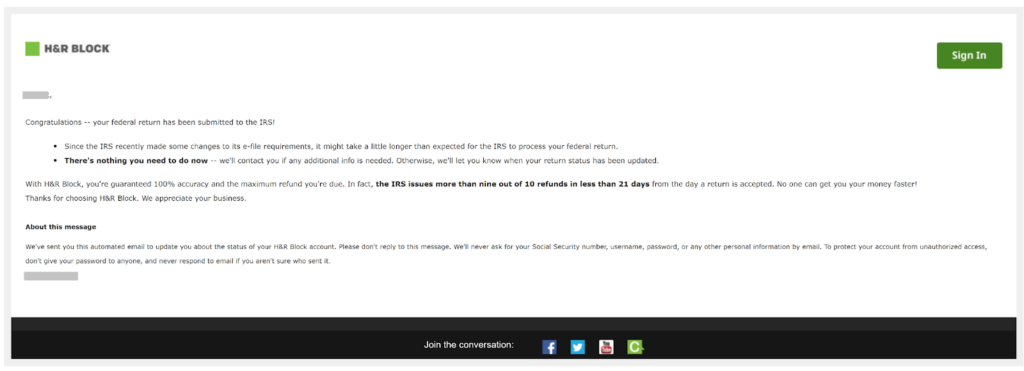
📨 We’ve Filed Your Federal Return
Not every delivery involves shipping a product. This email is sent to H&R Block customers who opted to use the online tax preparation service’s add-on filing service. The message notifies the customer that their tax return has been submitted.
Recognizing that waiting for a tax return to be processed can be stressful, the message provides clear information about what happens next and a warning about anticipated delays.
“There’s nothing you need to do now—we’ll contact you if any additional info is needed. Otherwise, we’ll let you know when your return status has been updated.”
An additional note at the bottom of the email reminds customers to protect their data, informing them that the provider will never ask them to share their Social Security number, password, or user name via email.
Protecting your customers from phishing scams protects your brand from negative feedback.
📧 Recurring charge confirmation: Zevia beverages uses email to remind customers about recurring subscription fees.
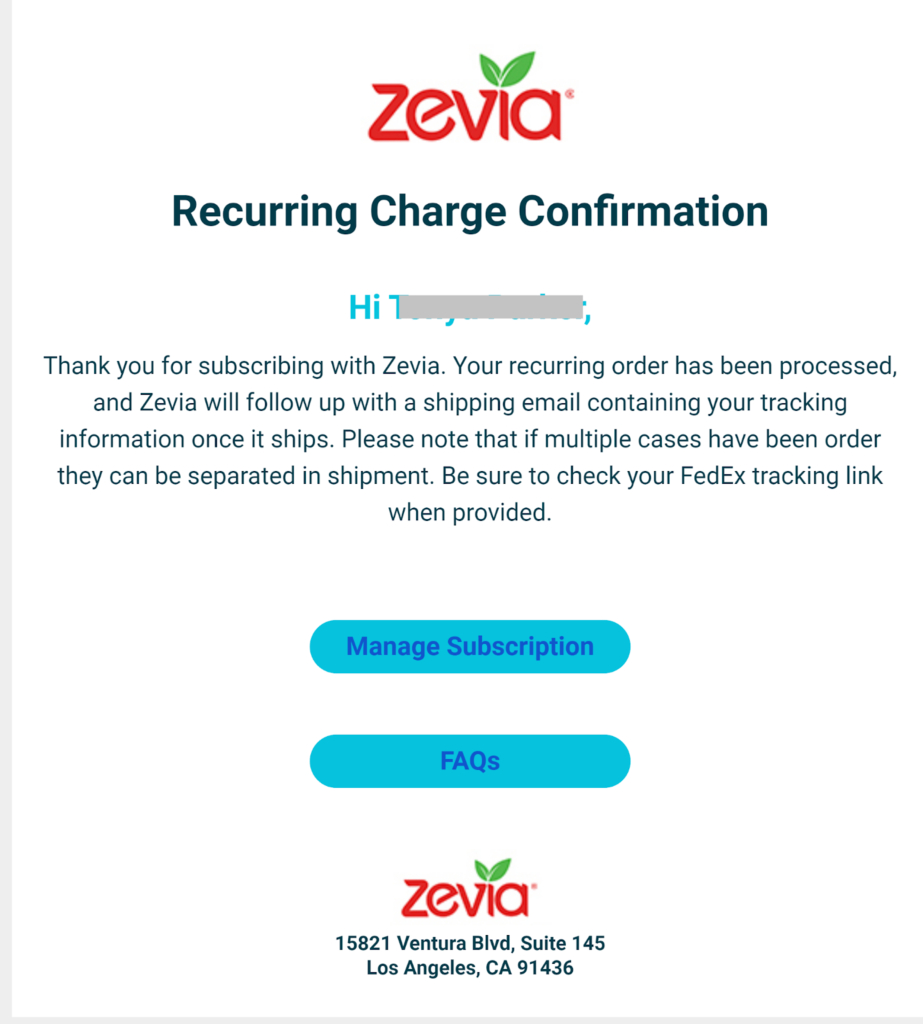
📨 Your recurring order charge confirmation from Zevia
Have you ever signed up to receive regular replenishments of a product and then forgotten about it? Some of your customers probably have, too. If you offer ongoing subscriptions or automatic replenishment shipments, give your customers a heads-up before you bill them.
In this message from Zevia, the beverage company alerts the customer that their recurring order is being processed and informs them of what will happen next. (They’ll receive a shipping notice and tracking code).
The prominent buttons direct customers to the “Manage Subscription” and FAQs pages in case they need more information or want to adjust their subscriptions.
A simple email like this one can save both you and your customers from unwelcome surprises and reversed payment hassles.
Auto-renewals are coming under increasing scrutiny by government entities, and at least 20 states have enacted laws regarding auto-renewal practices. Incorporating transparency into your renewal processes positions your organization to handle coming laws and consumer expectations.
Should you include promotional content in your confirmation messages?
Order confirmation, shipping, and delivery update emails are the foremost transactional messages. Whether you can include marketing content in these and other order updates will depend on the applicable laws and the consent you have from the recipient.
In many instances, you can include marketing content along with your transactional messages.
Should you engage in permission-based marketing through your order confirmation and update messages?
Yes–as long as you don’t lose focus.
After someone makes a purchase, they may feel anxious, impatient, or even be searching for a reason to change their minds. The primary objective of your post-purchase confirmation and order updates should be to reassure and inform your customer.
Prioritize frictionless customer service and satisfaction in your post-purchase transactional messages. Once you’ve made sure your email delivers the information that your customer cares about, then look for ways to add promotional value.
Here are some types of positive post-purchase marketing content you might include in your order confirmations and updates:
- Links to information that will enhance the customer’s purchase experience, such as how-to guides or community forums.
- A discount on the purchase of the same or different merchandise or an upgrade offer.
- An invitation to join your rewards, VIP program, or incentivized referral program.
- Recommendations for products that complement their purchase. Recommendations can be personalized based on your customer’s purchase or browsing history or general ones based on experts’ choices or your current best sellers.
💡Post-purchase transactional messages and updates can give you an advantage when it comes to inbox placement among email recipients who use multiple tabs in their Gmail inboxes. Your brand’s order confirmations, shipping and delivery updates, and monthly or annual renewal notices and updates are more likely to land in the Primary or Updates folder than solely marketing messages which will be directed to Gmail’s promotion tab.
Be careful not to put this placement at risk. Consider using separate From names and a separate IP or sub-domain to send non-marketing communications.
This article, The Ins and Outs of Transactional Emails, offers a complete guide for building transactional emails that perform double-duty as promotional communications for your brand.
Examples of post-purchase transactional emails with a promotional side
The following post-purchase emails demonstrate how to use confirmation emails as a means of upselling, cross-selling, and deepening your customers’ connection with your brand.
📧 Order confirmation with customized upsell and cross-sell product recommendations from Wayfair.

📨 Thanks for your order! – We’re getting your order ready now and we’ll let you know as soon as it ships.
Home goods retailer Wayfair masterfully employs email campaigns at every stage of its sales funnel.
This order confirmation email is just one example of the brand’s strategic use of post-purchase email sequences to inform customers and keep them moving forward on their buyer’s journey.
Wayfair’s first order confirmation message arrives before the selected items are ready for shipping and includes a CTA button directing the recipient to their order page. Employ strategically placed, action-oriented CTAs to optimize your post-purchase email conversion rates.
In addition to providing relevant order details and links, the message includes a recommendation section titled “Items Based on Your Purchase.” Customers see items that match or might accessorize or complement their purchase in this customized product recommendation section.
In the example I’ve shared, confirming the purchase of two area rugs, under-rug cushioning mats, and furniture are featured. The retailer also uses its digital sales receipt to introduce customers to its related family of brands.
📧 Shipping notice with product recommendations: Part of a complete post-purchase email sequence from Wayfair that invites customers to continue shopping with the brand.

📨 Part of your order has shipped! – The first package in your order is on the way! We’ll let you know as soon as the rest ships.
A shipping update from Wayfair issues once a purchased item ships and includes updated order details, including links to both the customer’s order and shipment tracking pages.
The button link in the shipping email resembles the button in the confirmation email. However, while the order confirmation button’s CTA says “View or Update Order,” this one says “Track Your Package.”
In the initial confirmation email, Wayfair notified their customer that the order would be shipped in two packages. This follow-up email uses color blocking and text to distinguish between the item it is about and the items remaining to be shipped.
Like the confirmation email template, this template includes a dynamic block that hosts customized product recommendations. These new recommendations include a mix of suggestions from the previous email plus a few new ones.
📊 67% of consumers surveyed want brands to send them relevant product and service recommendations. Two-thirds of these consumers also wanted to receive messages tailored to their needs and targeted promotions. (McKinsey)
Not missing an opportunity to draw customers back to the website and encourage another purchase, there’s also a linked upsell offer–a care and protection plan for the item being shipped.
Other links and CTA buttons invite consumers to connect with the brand by signing up to receive text updates or downloading a tracking app to stay on top of when their order will be delivered.

How customized can you make your post-purchase emails using product recommendations and other event-triggered content?
Check out this example from Wayfair sent to the same customer following another transaction.
📧 Shipping notification: Single-item shipment with customized product recommendations from Wayfair.

📨 Your order is on the way! – Good news – your item(s) are on the way!
Reflecting the fact that this single-item order isn’t being split into multiple shipments, the subject line for this shipping confirmation differs from the previous example I shared. The dynamic field used to insert a protection package offer for the other purchase isn’t present for this item either.
Finally, instead of rug accessories and living room furniture in the product recommendation section of the template, this email includes holiday decor related to the seasonal wreath that the shipping notice is about.
📧 Delivery notice: Wayfair finishes off its shipping sequence with an order arrival notification.

📨 Your Wayfair order was delivered – Woohoo! Your order has arrived!
Coordinate your after-order communications with your delivery partners so that you can notify your customers when their deliveries have arrived. This email from Wayfair includes the carrier’s name and a tracking number, and tips for finding a hard-to-spot package just in case the package isn’t where it is supposed to be.
The copy includes the following advice,
“Missing packages are stressful, but we have some good news: most items turn up within three days. Look around your house or building in out-of-the-way spots, or try these suggestions,” accompanied by a link to a resource page.
You may also have noticed that the brand follows a similar format in this post-purchase update as it has in previous messages. There are details about the item purchased, followed by a customized recommendation section under the header “Top Picks for You.”
For this final message in the transaction series, there are also images and links for the retailer’s “Limited Time Deals.”
Limited time or quantity offers and last-chance emails stimulate feelings of FOMO (fear of missing out) that can nudge your customers toward making a purchase decision fast.
Why so many Wayfair examples?
Well, they’ve been pretty effective at increasing sales with at least one Ongage Team member. I’ll show you their feedback request flow later in this article.
Wayfair isn’t the only one that uses its order and shipping confirmation messages to add value and engage recipients. ⤵️
📧 Shipping update email: David’s Tea sends a shipping update that includes the order’s details, a tracking link, and copy aimed at building the recipient’s anticipation.
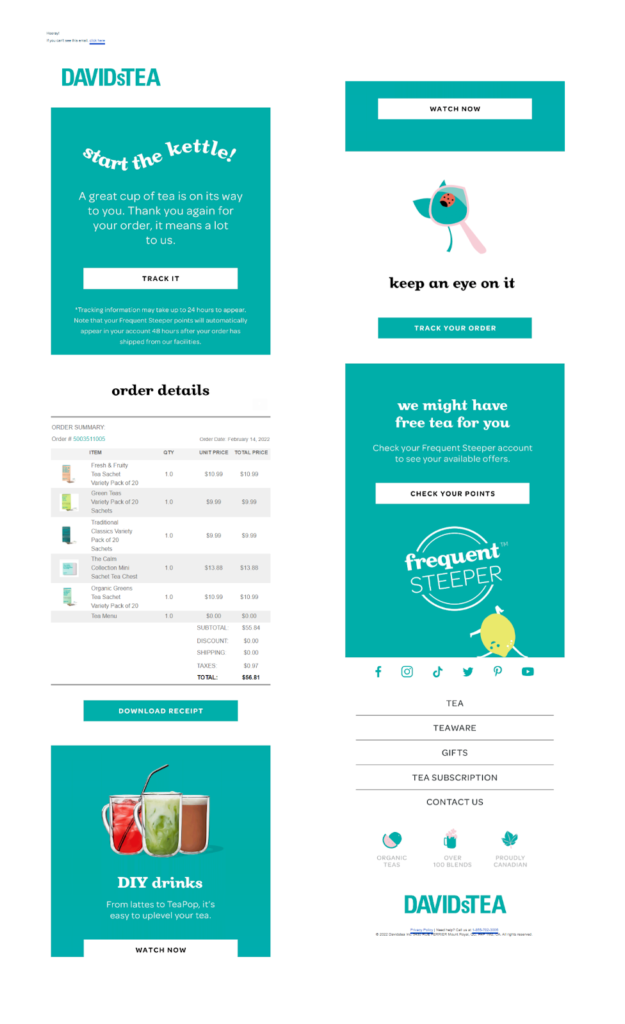
📨 {{First_Name}}, your order is on its way – Hooray!
David’s Tea remembers to say thanks, expressing the brand’s appreciation and heading off buyer’s remorse with a message that says,
“Start the kettle! A great cup of tea is on its way to you. Thank you again for your order, it means a lot to us.”
This shipping notification uses a mix of content types to add value, including a linked video with instructions for making drinks using the brand’s teas and a reminder for the subscriber to check their “Frequent Steeper” reward points total.
The email’s design incorporates typographical cues and attractive, on-brand color blocking to make key information (and each CTA button) easy for customers to spot.
👀 Is adding video to your emails difficult to manage at scale? Nope! Learn several techniques for incorporating videos into your email campaigns in our article, Video Email Marketing: Tips, Strategies, and Examples.
Keeping your customers updated about their purchases is an essential function of your after sales email campaigns. Ensuring a positive post purchase shipping and delivery experience takes your house from straw to sticks. That’s why your first few contacts should prioritize communicating the necessary information.
However, your buyer’s journey doesn’t have to end once their package arrives or they’ve activated their digital subscription.
Non-transactional after-sales email campaigns nurture long-term customer relationships that strengthen your sales pipeline and increase revenue.
First purchase welcome and onboarding emails build a solid foundation for your customer relationships
People’s paths to purchases aren’t linear, and they don’t always progress at the same pace or in the same way. Your new customer may have converted after clicking on an ad or receiving a recommendation from a friend.
Someone may be exposed to your brand across several channels or just one or two. They may be an existing email subscriber or someone new to your brand.
If a new customer signs up to your subscription list at checkout or immediately prior to purchase to receive a promised sign-up incentive, you may send a double opt-in or confirmation email to them before their first order email arrives.
Emails that ask for a response from the recipient allow brands to validate new subscribers’ addresses and earn engagement that helps place subsequent messages in the recipient’s inbox.
📧 Email list subscription confirmations: Bones Coffee validates new emails and confirms interest with a double opt-in message.
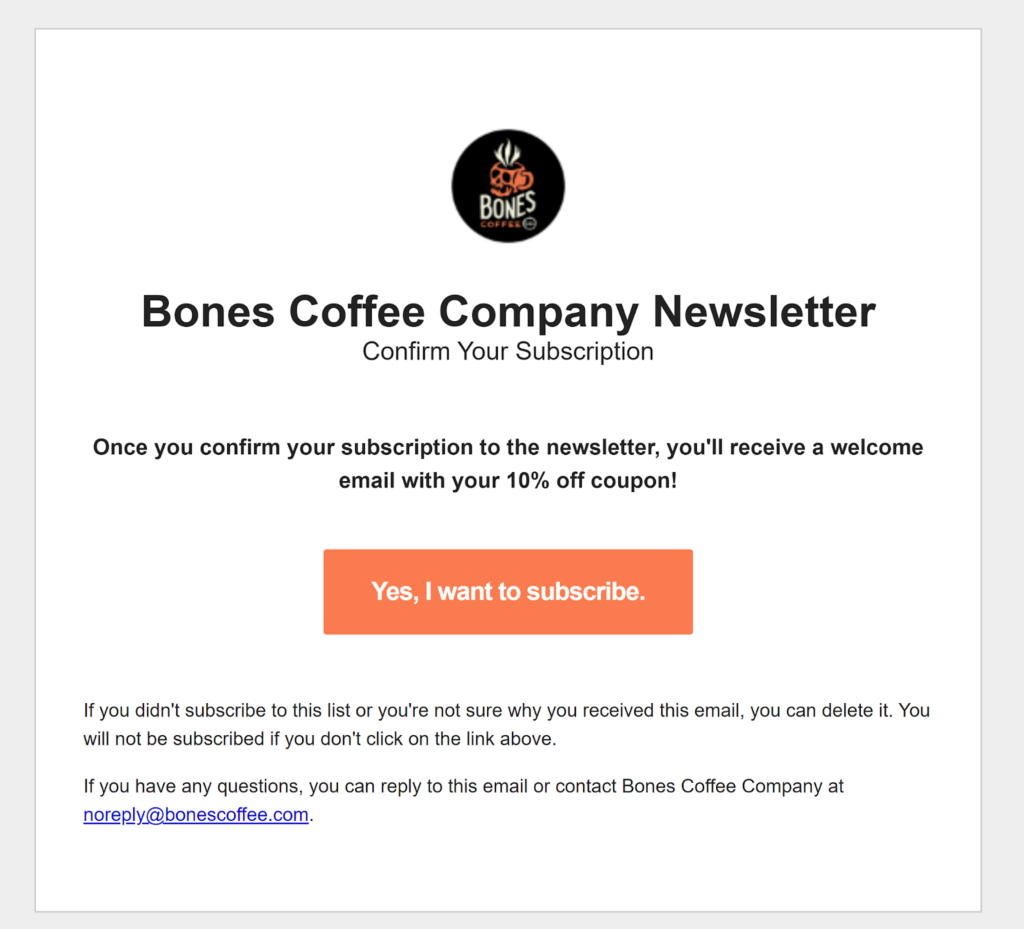
📨 Confirm your subscription – Bones Coffee Company Newsletter
Bones Coffee’s subscription confirmation autoresponder splits the sign-up interaction. This first email is solely transactional, indicating that once the subscriber confirms their address, they’ll receive their welcome email with the promised code.
Businesses for which the newsletter subscription is the product, such as Morning Brew, The Information, and DailyCTA, also use subscription confirmation emails as first post-purchase (or post-conversion) contact.
💡 Employ email segmentation and automation to create separate email sequences for pre-purchase subscribers and those who sign up at the time of purchase. Use different templates or dynamic content blocks that change your standard confirmation and welcome messaging to avoid overwhelming your subscribers’ inboxes.
There’s much more to welcome campaigns than confirming someone’s address and interest, though.
Welcome and onboarding emails build a solid foundation for growth
Welcome and onboarding emails are your business’s opportunity to make a second first impression.
You’ve already charmed the recipient enough to convert them to a customer, now it’s time to let them get to know you better.
Your welcome and onboarding emails are an opportunity to
- Acknowledge new customers and engage them via email.
- Show your appreciation for their interest in your brand.
- Deliver content to counteract any potential buyer’s remorse.
- Lay the foundation for a beneficial ongoing relationship.
- Provide links and contact information for customer service and support resources.
- Move customers forward on their journey by guiding them toward the successful use of your product or service.
- Encourage return sales and prevent drop-offs before a second sale occurs.
- Request feedback and prevent poor post-purchase experiences.
These post-purchase welcome and onboarding examples charmed the Ongage Team.
📧 SaaS welcome and introduction email example from Branalyzer.
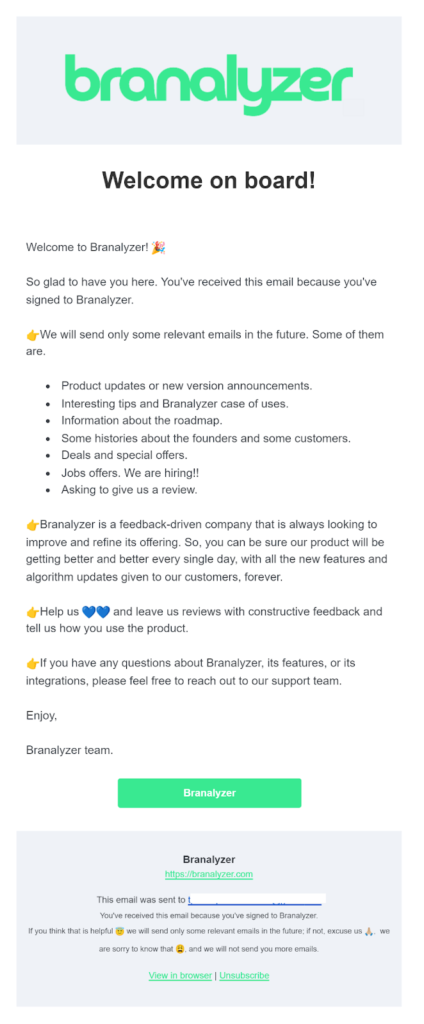
📨 Welcome to Branalyzer👋👋 – **Welcome on board!**
This welcome email from Branalyzer is an example of a message sent to a new customer, welcoming them to the brand’s email list and the app.
The message opens with an enthusiastic welcome before detailing the types of content the new subscriber can expect to receive from the brand.
The opening copy reads,
“Welcome on board!… Welcome to Branalyzer!
After this introduction, the email continues by inviting new customer-subscribes to provide feedback, writing
“Branalyzer is a feedback-driven company that is always looking to improve… Help us💙💙 and leave us reviews with constructive feedback and tell us how you use the product.”
The email closes by encouraging new customers to reach out to the support team if they have any problems or questions above the button CTA which directs recipients to the data tool.
This simple message covers a lot of ground. It expresses appreciation, asks for input, and offers assistance to new members of the Branalzyer community.
📧 Meet the brand welcome email from NEOM.

📨 Get to know us – What we’ve done, what we’re doing and where we’re headed…
This welcome email from organic household goods seller NEOM makes sure new customers and subscribers understand the brand’s values.
Shared values are a decisive factor for many modern shoppers. So getting this information to them early and often can help solidify your business’s credibility and your new customers’ loyalty.
“Get to know us,” is the header (and theme) for this email. The opening paragraph says,
“Whilst your wellbeing is at the heart of everything we do, we also wanted to let you know about our promises to sustainability, charity partnerships and where we’re headed…”
NEOM’s onboarding message includes an explanatory copy and invites recipients to click through to learn more. Guiding email recipients to connect and explore your website improves your engagement rates (which supports future deliverability) and takes one step closer to making their next purchase.
This email also includes a 15% off purchase code as an extra nudge to act.
📧 New Customer welcome and perks promotion: Puritan’s Pride creates an attractive introductory email to welcome new customers.
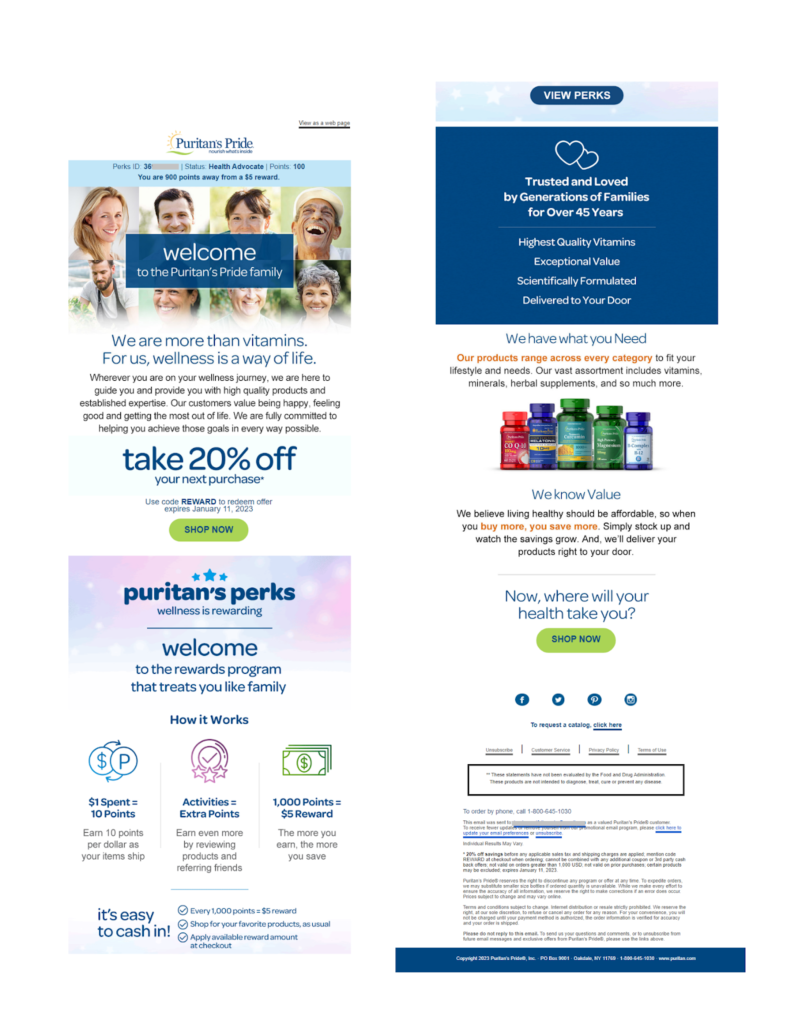
📨 Hi {{First_Name}}, and welcome to Puritan’s Pride! – Puritan’s Pride® – Nourish what’s inside
Vitamin and supplement seller Puritan’s Pride has a lot to gain from encouraging repeat customers who return to the brand for refills of their favorite health supplements month after month.
The brand uses its post-purchase welcome message to incentivize that all-important second purchase with a 20% discount to lift the business’s repeat customer rate.
Adding a “what’s in it for me element,” the email’s header includes dynamic content that tallies the new customer’s rewards point status showing them the value of loyalty.
After introducing the discount offer in the first panel, this welcome and onboarding email template presents an explanation of how the brand’s perks program works, followed by a trust-building panel with copy that says,
“Trusted and lived by generations of families for over 45 years.”
The design adheres to the brand’s color palette and style while using contrasting colors to guide viewers from one panel (and message) to the next.
Other subheadings emphasize the convenience of ordering from a business that carries a wide range of products,
“We have what you need…”
and the savings the seller offers,
“We know value… when you buy more, you save more. Simply stock up and watch the savings grow…”
Rewards programs are a smart way to encourage repeat purchases and create use habits that bring customers back to your brand again and again.
Examples of post-purchase onboarding emails that nudge digital product adoption
When you ship a physical product to your customers, you have a built-in opportunity to onboard them using package inserts, use instructions, and other materials.
But when your product is digital, you have to handle all your onboarding via digital mediums. In-app tool tips and guides can help. But don’t overlook the power of email to encourage adoption and get new users to that “aha!” moment that will transition them from interested to invested.
The following post-purchase emails aim to build engagement by introducing features and actively encouraging customers to take the next step in their buyer’s journey.
📧 New publication subscriber welcome email from NatGeo.
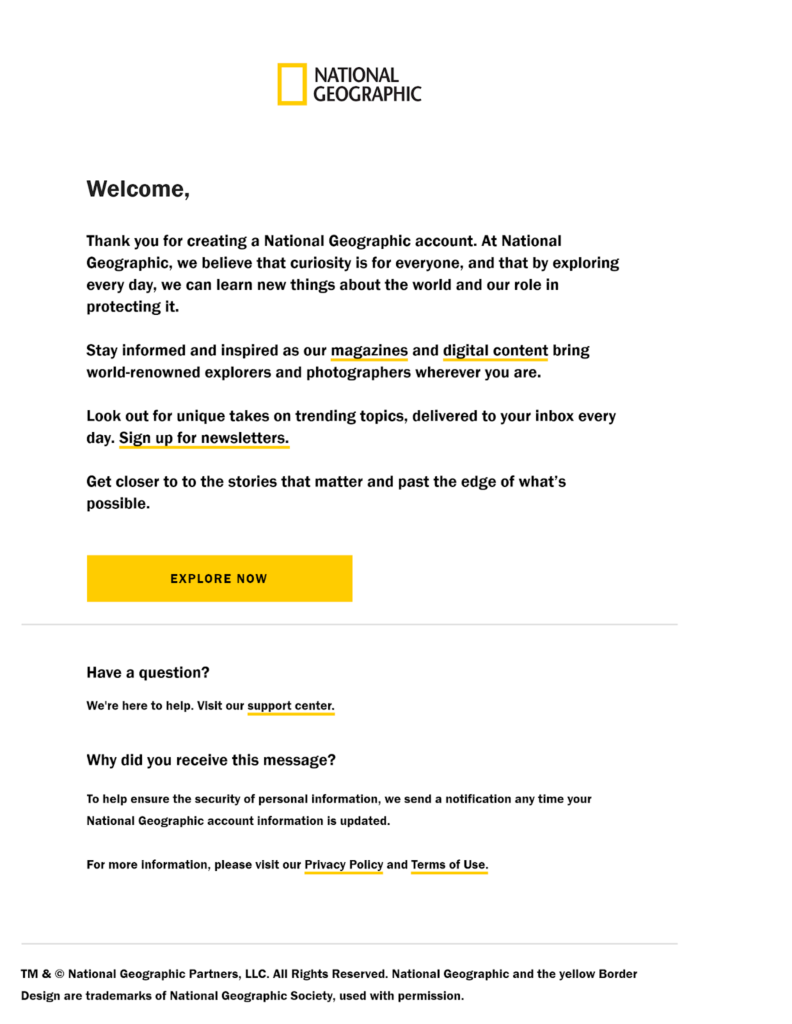
📨 Welcome to National Geographic
Digital and physical magazine publisher National Geographic sends new account holders a welcome email that introduces them to all the resources available to them.
This welcoming message encourages subscribers to begin using their subscription and extract value from it–an important customer retention metric.
The simple and mostly text message while maintaining the brand’s style through use of its iconic black and yellow color combination. Also on-brand for a magazine dedicated to discovering the world’s farthest corners is the “Explore Now” copy on the button CTA.
When someone sets up a new account, National Geographic sends them this email and a separate autoresponder that includes their login information.
Other messages in the publisher’s onboarding series encourage subscribers to explore more of the company’s online content and help the brand learn more about its users.
📧 Post-subscription onboarding and preference information request from National Geographic.

📨 You’re on the list to get the inside scoop! – So excited you are curious about the world – so are we!
This message in National Geographic’s onboarding sequence introduces specific topic areas using images accompanied by distinctive CTA buttons.
For example, the top left image’s text says, “Enter the “cave of the thousand mummies” and its yellow CTA button says “Explore the cave.”
At the bottom right, the image copy reads, “Welcome to the Island of the Colorblind. See what paradise looks like to the people who live here.” This block’s CTA says, “Change your perspective.”
Not only does presenting new subscribers with multiple options improve the chances that they’ll find the content they want to explore, but recipients’ click-throughs provide valuable data about what works and what doesn’t.
After presenting these selections, this panel of the email includes a section that says,
“Like what you see? Why not get curated content straight to your inbox? Check out our amazing newsletters.”
A “Sign up for Newsletters” button leads customers to a newsletter preference page–and gives the brand another opportunity to learn about them.
Descriptive call-to-actions that tell readers what’s behind the click can increase your email conversion rates.
Finally, this template uses contrasting colors to separate the last panel promoting the publisher’s app. This same black color in the email’s header and footer frame the content.
Mix-and-match content panels allow you to change your messaging to suit various objectives, acknowledge seasonal changes or meet the expectations of different audience segments.
📧 Action-prompting SaaS email onboarding message: Stripo offers a little something for everyone in this multi-panel onboarding email.
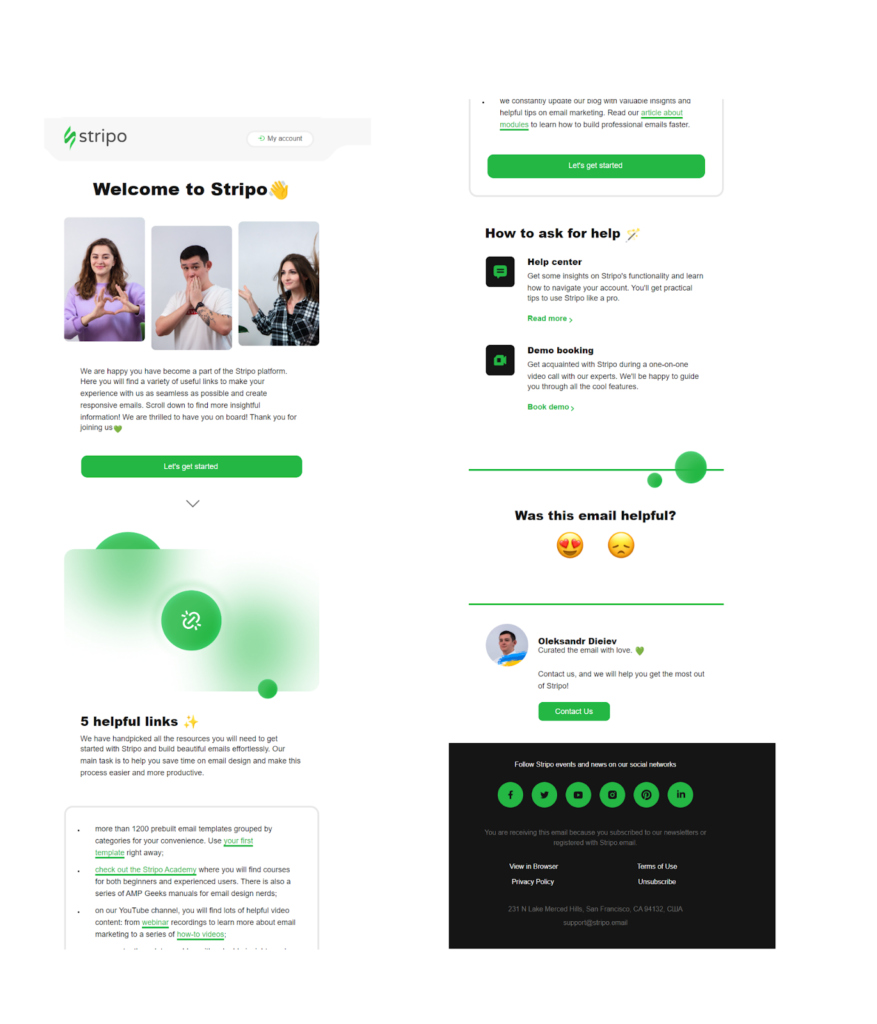
📨 📗 Your first day with Stripo!
Stripo’s product is purely digital. If new customers don’t visit the brand’s website and use the tool, they won’t discover its benefits or become repeat purchasers or advocates. So getting them past this milestone is pretty darn important for the brand.
This email employs images and copy to give the message a human touch and uses various types of content and visual cues to encourage recipients to act.
The opening sentence under the “Welcome to Stripo” header says,
“We are happy you have become a part of the Stripo platform. Here you will find a variety of useful links to make your experience with us as seamless as possible and create responsive emails… We are thrilled to have you on board! Thank you for joining us 💚”
The main call-to-action, “Let’s get started” appears on both of the Stripo-green CTA buttons. Other text-based CTAs and in-line links appear throughout the copy.
The implicit message of this email is polite but clear: Read more, use your first template, check out the Stripo Academy, book a demo, watch a how-to video… just get started!
I like this email’s use of white space. While the message packs in a lot of information, the color and spacing prevent it from being visually overwhelming.
Examples of emails asking for experience feedback and product reviews
Businesses interested in continuous improvement need continuous input to achieve that goal. Your customers are an excellent source of data about your purchase and fulfillment performance and the quality and value of individual products. Gather and monitor this information to avoid problems and identify opportunities.
Customer product reviews also provide you with valuable social proof that increases your brand’s credibility and instills confidence in first-time buyers. (Well, assuming those reviews are mostly positive.)
Purchase experience and product review email requests:
- Demonstrate that the seller cares about their customers’ satisfaction and post-purchase experience.
- Enables the brand to gain valuable customer reviews and testimonials for their products.
- Helps sellers uncover flaws in their fulfillment process.
- Earns the sender deliverability-boosting engagement for their email campaigns.
Review requests can take the form of a single autoresponder or be part of a larger post-purchase email sequence.
When sending a request for a product review, timing is important. Selecting the best time to send these emails involves more than knowing when your customers are most likely to be viewing their inbox.
You shouldn’t ask for a review before your product has arrived. Your customers may forget about the request while waiting on delivery or leave a negative review if their package arrives damaged (or doesn’t arrive at all).
Schedule your review request to arrive a few days after your customer’s purchase is recorded in your fulfillment database as delivered (or after they’ve downloaded or installed your digital product). This will allow your customer time to experience their new purchase before you ask them to tell you what they think.
Use your email marketing platform’s dynamic content features to personalize your requests at scale.
📧 Customer experience feedback requests: Lego asks how things went following a purchase.
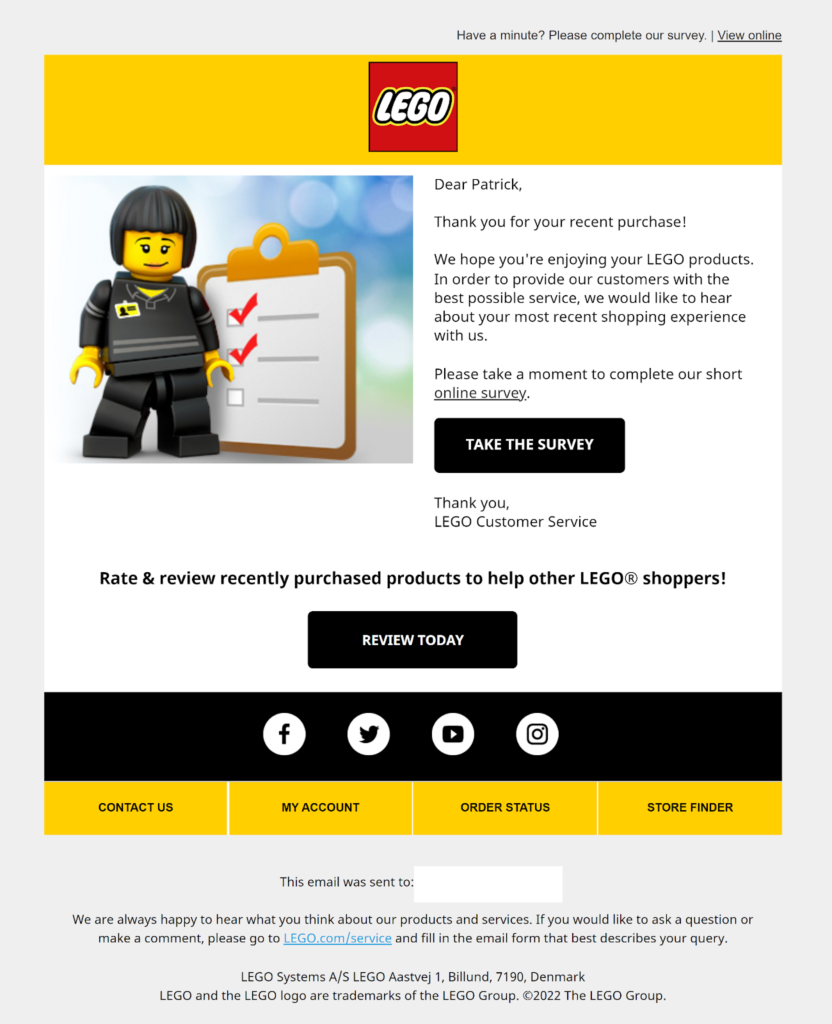
📨 Thank you for your recent LEGO® purchase. – Have a minute? Please complete our survey
Lego sends product review requests and post-purchase experience surveys to its customers. Each feedback type serves a different purpose for the brand.
The above email is an example of the toy brand’s post-purchase experience survey invitation. This survey and other customer loyalty metrics help Lego understand its audience and its performance. This email uses a secondary CTA to invite recipients to review their recent purchases.
The copy begins with a thank you before stating its purpose,
We hope you’re enjoying your LEGO products. In order to provide our customers with the best service possible, we would like to hear about your most recent shopping experience with us. Please take a moment to complete our short online survey.”
It never hurts to include an extra thank you or two in your post-purchase messaging.
📧 An automated review request built with dynamic fields and blocks: Macy’s makes asking for post-purchase feedback automatic.
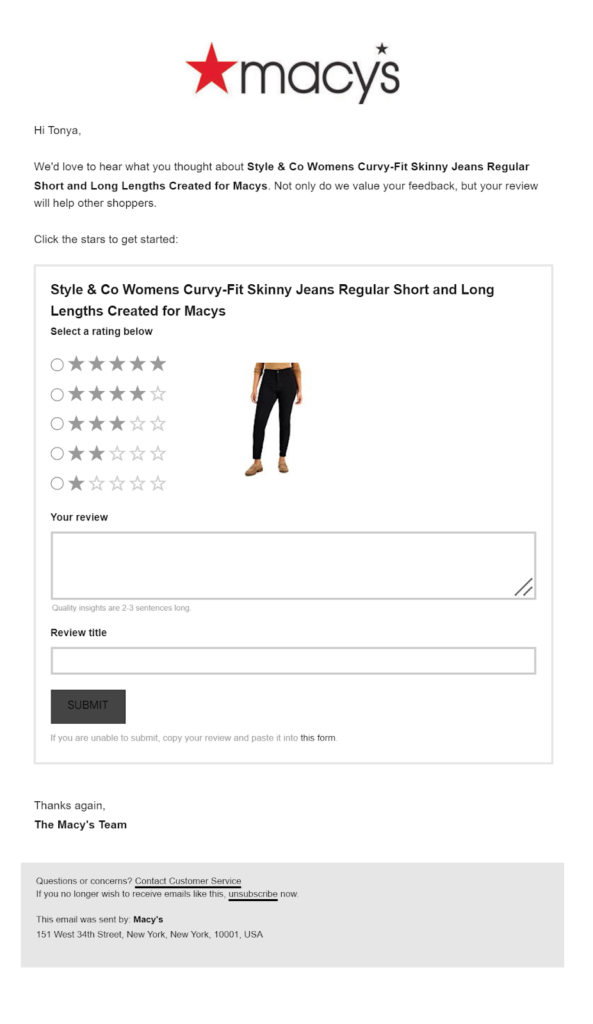
📨 Love what you bought? Review it! – Hi {{First_Name}}, We’d love to hear what you thought about {{Item purchased}}}.
Dynamic content plus event-triggered automation makes sending product review requests easy for retailer Macy’s. The brand sends a request to each customer after their products are delivered.
Did you notice the subject line on this review request email?
It asks the recipient if they “loved what they bought.”
This language is a method to pre-screen your reviewers without overtly excluding potential negative reviews.
Someone who is happy or likes your brand is more likely to open this message and respond than someone who feels neutral or unhappy. You may still get a few very unhappy customers who will open the message and complete the steps to leave a bad review, but your subject line doesn’t encourage them to do so. Get it?
📧 Post-purchase feedback requests: Wayfair caps off its order, shipping and delivery flow with requests for feedback.
Wayfair’s comprehensive email flow includes messages aimed at obtaining feedback about specific products and its customers’ purchase experiences.
Each of the single-question net promoter score (NPS) style feedback requests (pictured below) references the same order number–I’m inferring that the selection process is random or triggered by a specific number of orders or order values.
If the recipient responds, they are taken to a webpage where they are asked to provide an unstructured, text-based answer to a follow-up question.
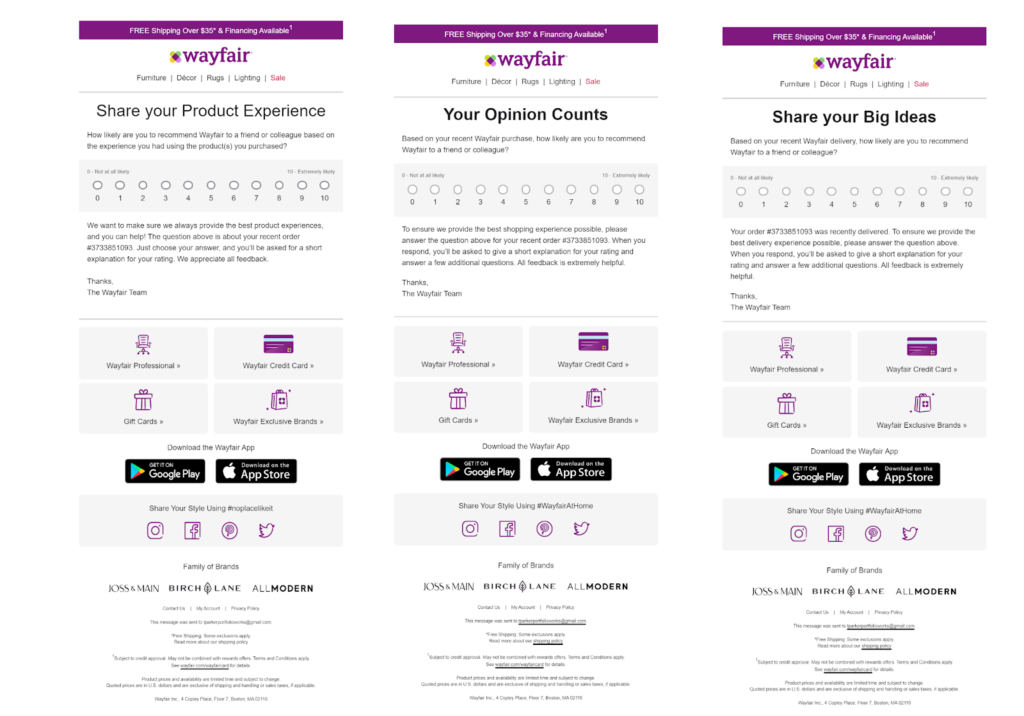
Matching left to right with top to bottom, the three messages pictured above each ask the recipients for slightly different feedback (listed below):
📨 Did you love our products? – on your Wayfair purchase inside.
“Share your product experience… How likely are you to recommend Wayfair to a friend or colleague based on the experience you had using the product(s) you purchased?”
📨 Wayfair requests your feedback – One question, and it takes less than a minute!
“Your opinion counts… Based on your recent Wayfair purchase, how likely are you to recommend Wayfair to a friend or colleague.”
The third email in my collection asks about the customer’s delivery experience.
📨 How was your delivery experience? – your recent Wayfair experience means a lot to us. One question and it takes less than a minute!
“Share your big ideas… Based on your recent Wayfair delivery, how likely are you to recommend Wayfair to a friend or colleague?
Adding dynamic fields or blocks controlled with If-Then-Else rules to a basic feedback request template (and your subject lines and preview texts) like Wayfair has done enables you to alter your content between subscribers or send slightly different versions of an email to the same subscriber.
An email marketing platform with advanced triggers and branched email flow capabilities offers you multiple ways to execute unique and timely messaging across a wide audience.
After-the-sale emails that invite a deeper understanding of your customers through interactive content or preference requests
Inviting your customers to tell you about their experiences with your brand or its products isn’t the only way to learn more about them and improve your performance.
Messages that gather your customers’ purchase and communication preferences show that you respect their data privacy concerns and their opinions.
In addition to covering the basics like email topics and frequencies, use your email channel to get input about the product, pricing, positioning, and customer experiences. Create polls to select new product colors or styles, find local stores where your customers would like to see your merchandise sold, or even set new price points.
Quizzes and other interactive devices that collect direct input from your customers and subscribers enables you to gather valuable zero-party data about them in ways that are more interesting and entertaining than a basic fill-in-the-blanks form.
📧 An email preference center invite: Tablecloths Factory puts customers’ email and shopping experiences in their control.
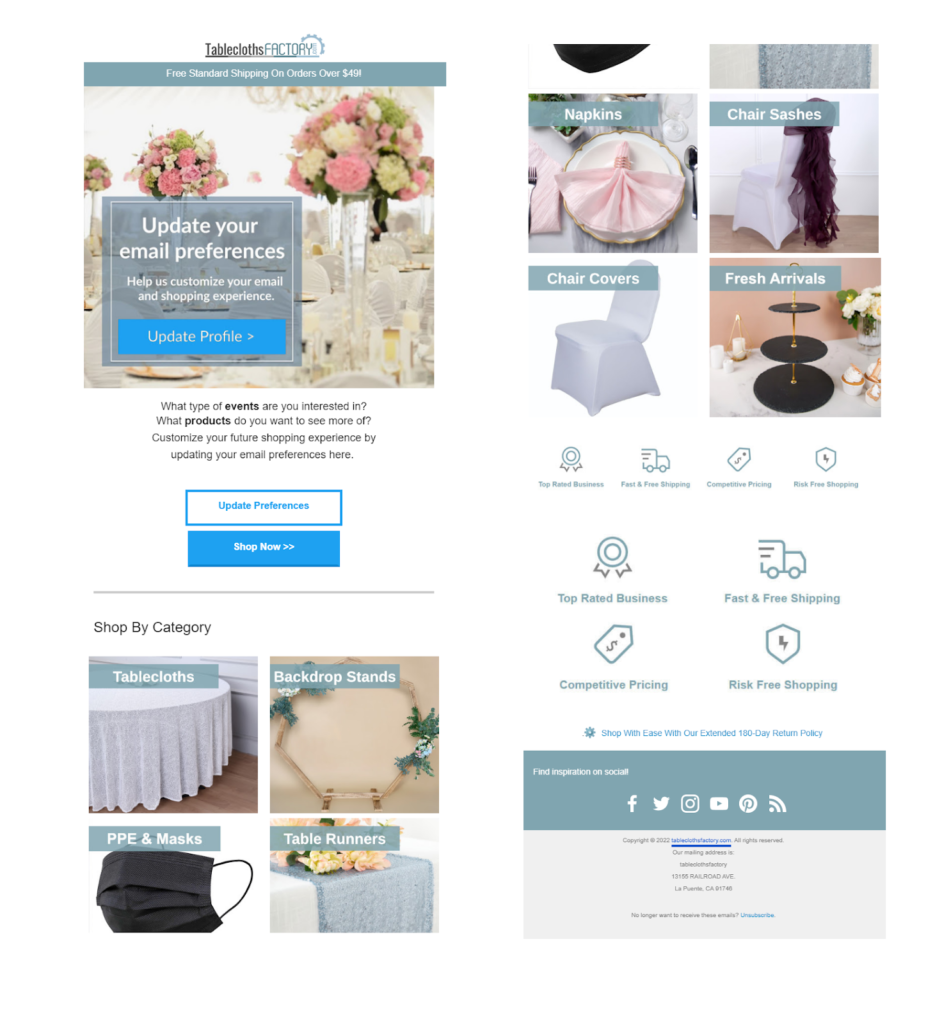
📨 Customize your email and shopping experience – Free Standard Shipping on Orders Over $49!
Entertainment supply outlet, Tablecloths Factory caters to individual and professional shoppers. Knowing their customers’ interests and needs helps the brand segment its audience and know which types of merchandise to recommend.
Are they serving a bride who needs supplies for her one-of-a-kind wedding or a bridal planner who will revisit the site and make repeat purchases regularly?
This email gets to the point quickly with an “Update your email preferences” header and a brightly colored “Update Profile” CTA button.
Following this hero panel, the message explains why the brand is asking,
“What types of events are you interested in? What products do you want to see more of? Customize your future shopping experience by updating your email preferences here.”
Another preference CTA and a “Shop Now” button close out the email’s primary message which then concludes with a collection of image-capped links to various product categories and templated content including social media links and trust signals.
📧 Welcome and set your preference email: 45NRTH introduces its brand with a brief message and a link to its email preference center.
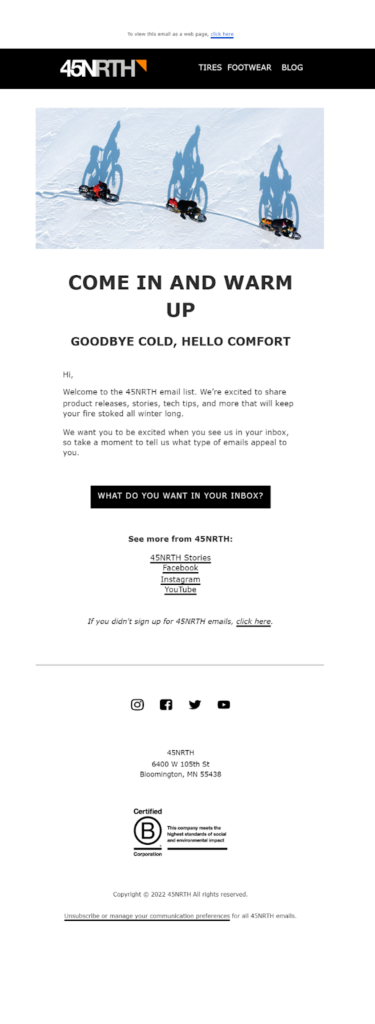
📨 A Warm Welcome from 45NRTH – to the 45NRTH email list. We’re excited to share product releases, stories, tech tips and more…
This cold weather sportswear and equipment brand sends a crisp, concise email that gives subscribers a glimpse of what to expect and then lets them tell the brand what they want to see.
“We want you to be excited when you see us in your inbox, so take a moment to tell us what types of emails appeal to you.”
The copy on this CTA button goes beyond the usual, “go to preference center.” Instead, it reiterates that subscribers are in control, saying:
“What do you want in your inbox?”
Collect preference center data from your subscriber to determine what types of emails they want to receive from you and how often. Use this information, along with other customer data, to build list segments and tailor your content for each group.
📧 CPG brand, Axe, invites customers to select a new scent for 2023 with an interactive poll.
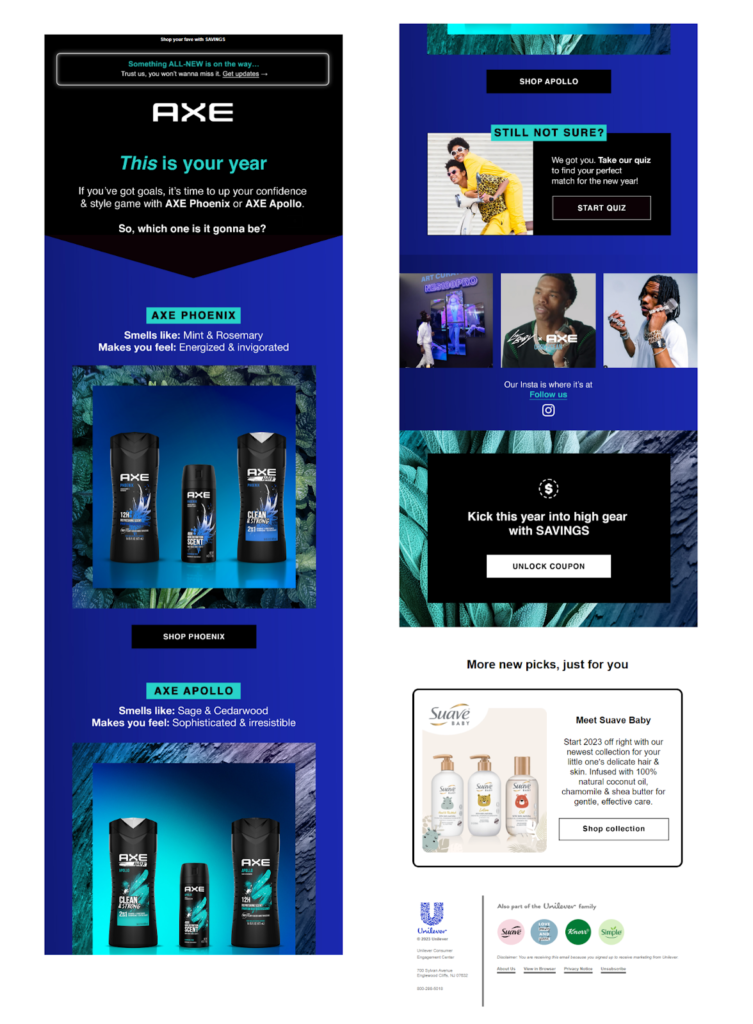
📨 💬 POLL: What’s your scent for 2023? – Shop your fave with SAVINGS Something ALL-NEW is on the way…
This clever and colorful campaign from men’s hygiene brand Axe achieves more than one objective.
The message solicits customer feedback and engagement with a poll that invites them to select (and shop) their favorite scent. At the same time, the message introduces these two new scent options for the brand’s product lineup.
A separate CTA continues the advance toward engagement and data collection by inviting indecisive customers to take a quiz to identify their “perfect match.”
The email builds a community vibe with images from Axe’s Instagram page before providing a button that will take customers to a page where they can get the savings coupons promised in the preview text.
Not missing a chance to cross-sell, this email closes with a promo for another Unilever brand and links to still other brands in the “Unilever family.”
📧 An invitation to influence future styles from Modern Citizen.

📨 Our signature styles are back in stock ✔️ – Share your feedback + get 15% off (including sale!)
An elegant email featuring images of Modern Citizen’s classic clothing and announcing that popular styles are back in stock closes with an invitation to take the brand’s annual customer survey.
The text over image says,
“Help us build the future of Modern Citizen by sharing your feedback — and get an exclusive code for 15% off (including sale!) upon survey completion.”
Offering an incentive for feedback can increase your completion rates. Modern Citizen stands to gain both valuable feedback and conversions with this 15% off incentive.
📧 B2B relationship building through email input request: An invitation to help plan the next CloudWorld conference from Oracle.
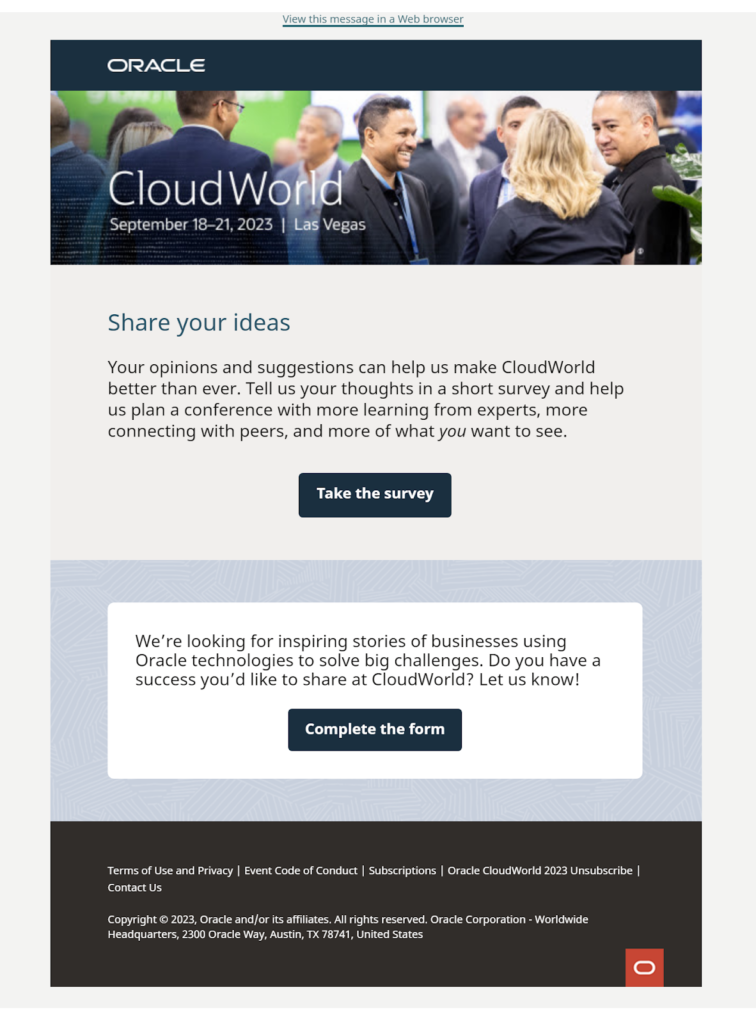
📨Tell us what you want to learn and experience at CloudWorld – Take a short survey and tell us what you’d like to see in Las Vegas, September 18-21.
Teachers and parents advise that if you want your kids to be interested in something you should make them a participant in planning or preparing it. So if you want them to eat a meal with veggies, you get them to help plant or select the veggies or prepare the meal.
Do you suppose that works for conference attendees, too?
Oracle seems to think so.
In this email, the business solutions provider asks prospective conference attendees to complete a survey telling the brand what they’d like to see at the conference with messaging that asks them to invest.
“Your opinions and suggestions can help us make CloudWorld better than ever. Tell us your thoughts in a short survey and help us plan a conference with more learning from experts, more connecting with peers, and more of what you want to see.”
Like other expert messaging, this email performs double duty, seeking feedback and promoting the benefits of the event in the same copy.
💡 You may have also noticed that this and other feedback request messages mention that the recipient’s time commitment will be short. Most people don’t respond favorably to being asked to take a “long survey.” The more specific about how brief your survey is, the better. Use benchmarks such as the number of minutes it will take to complete, or the number of questions survey takers will be asked to answer to convey brevity precisely.
Post-purchase nurture email examples delivering value-adding and customer success content
Sending your customer-subscribers value-adding content is an attraction marketing method. This method signals to your email recipients that your brand is a source of useful information, entertainment, a sense of belonging, and positive interactions that will add value to their lives.
These types of communications may include a direct promotional element–after all a good discount always makes me feel happy–but don’t have to.
And, your attraction marketing or value-adding communications shouldn’t always include a sales promotion.
Why not?
Because people like a little variety in their inbox.
Sure, they also like consistency. For example, they want businesses to be consistent in the values they express and demonstrate, and most of us prefer brands that don’t change their style or tone of voice often.
But you should give people a break from sales-focused emails now and then and focus instead on your values, company culture, and providing information that matters to your customers.
Community-building endeavors such as sharing news, inviting community participation or user-generated content helps nurture your long-term customer relationships, too.
📊 82% of consumers prefer brands with values that align with their own. (Retail TouchPoints)
As I mentioned at the start of this section, there are a lot of ways to add value from offering savings to sharing educational content.
I’m going to share a few examples of value-adding post-purchase emails with you with the disclaimer that these examples don’t come close to covering all the possibilities.
Use the following examples of customer relationship building emails for inspiration, then let your imagination take your post-purchase emails even further!
📧 Staying top-of-mind for low frequency purchases. F.C. Tucker sends market updates to past home buyers.
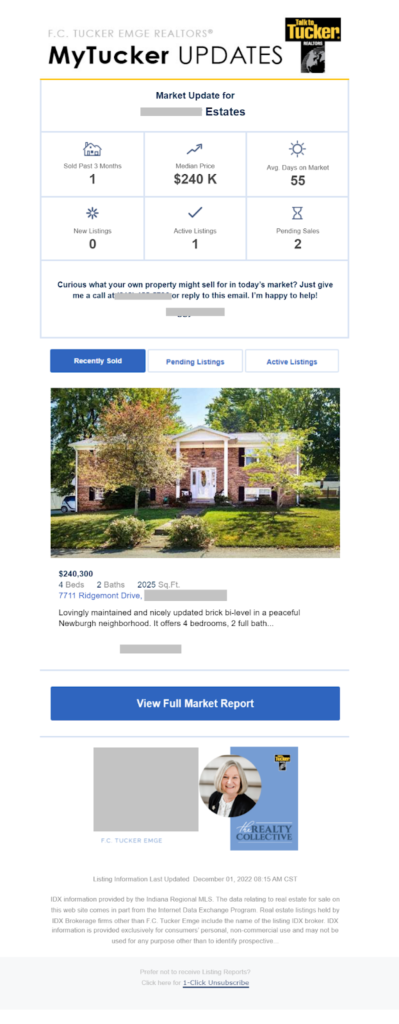
📨 {{Neighborhood}} Market Update – Market update for {{Neighborhood}} Sold Past 3 Months
US-based Realtor FC Tucker enables individual brokers to send customized messages to past clients keeping them up to date on market activity in their neighborhood. These messages keep the Realtors on homeowners’ minds for the next time they are in the market to buy or sell.
Businesses with long sales cycles have to find value-adding reasons to stay in touch between conversions.
📧 Post-purchase content that educates and informs from Enjoy Life Foods.
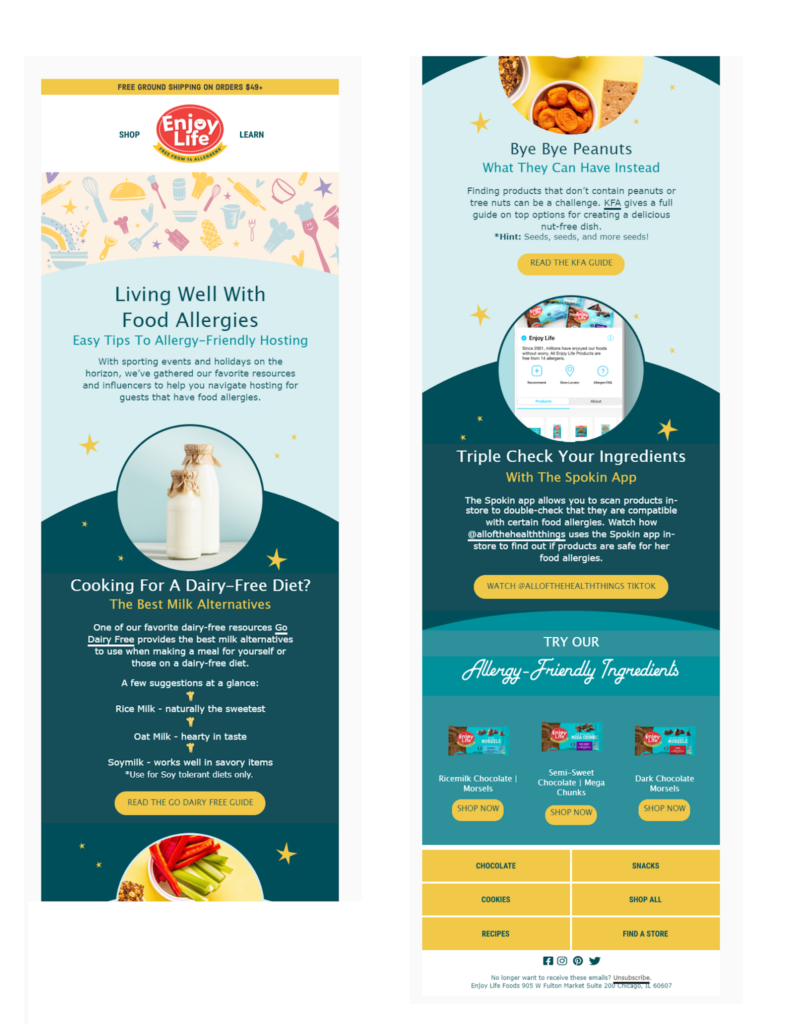
📨Hosting, Made Easy 🧑🍳- Discover 3 trusted guides
Enjoy Life Foods sells products that are free of most major allergens so people with allergies and the people who cook for them make up a large part of the brand’s customer base. This email offers customers a selection of tips for serving allergy-friendly foods at their next family or friends gathering.
This post-purchase message includes links to specialty pages where email recipients can learn more, as well as links to product pages. Other resources shared in the email include the Kids With Food Allergies peanut and tree nut substitution guide and an app that helps people with food allergies check the ingredients on products while shopping in-store.
Allying with your customers to help them live better and safer is a great way to show you care and build brand loyalty.
📧 New feature announcement email: AllTrails tells email subscribers about upgrades to their hiking app.
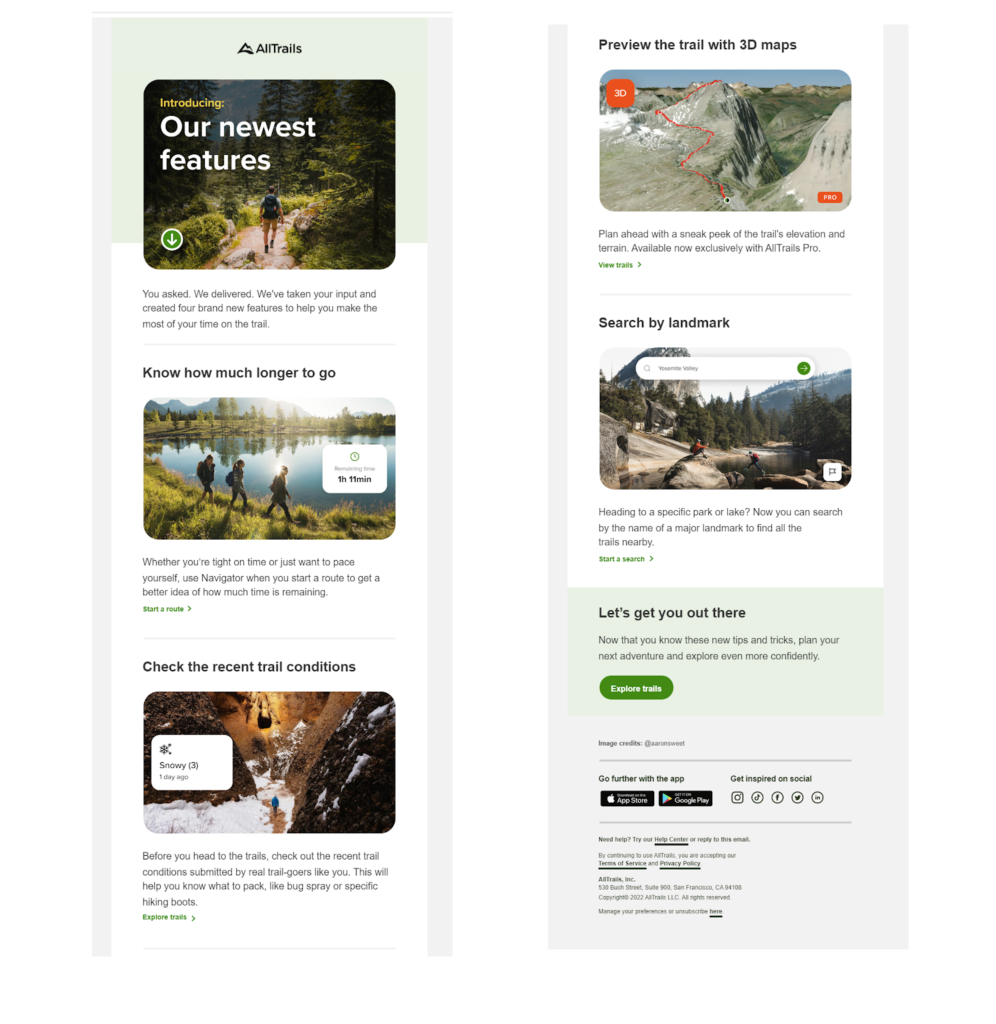
📨 We’ve added new features to make trail time even better! – Before you head out to the trails, try out any of these planning features for a better time outside
AllTrails uses text and nature-themed images to introduce and explain each new feature along with a link that invites subscribers to explore more or use the app. This quick introduction ensures that customers get the most out of their app subscription and may remind lapsed users of what they’re missing.
Encouraging use and maximizing value both aid your brand’s retention efforts.
📧 Sending subscribers social proof after their purchase confirms their good taste: Oui the People uses testimonials to instill confidence in its products.
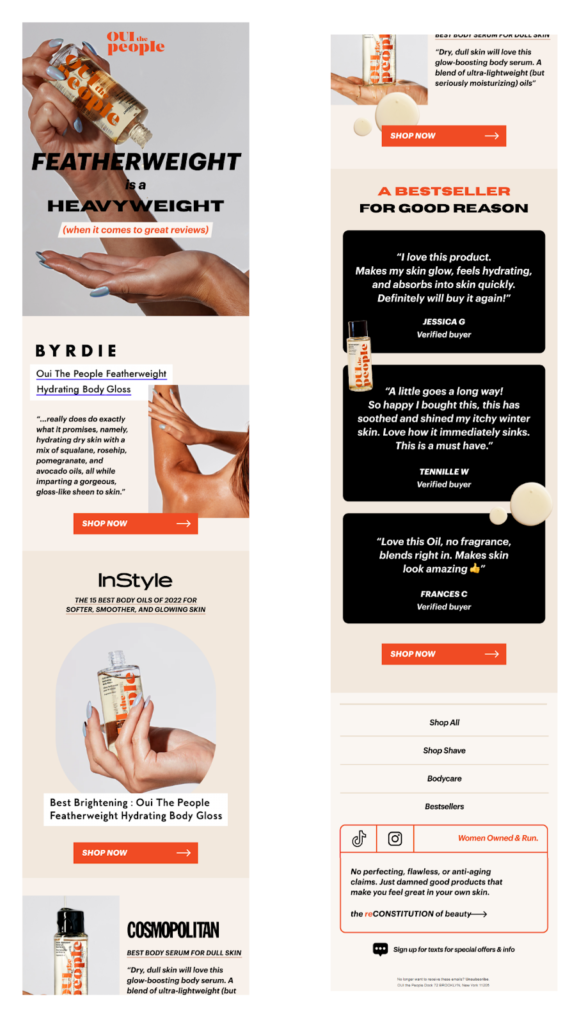
📨 People love to talk… About Featherweight.
This product-promoting email from cosmetics brand Oui the People centers on a single product, the Featherweight Body Gloss. Showing images of the product and the product in use along with customer and media testimonials, this email tells the product’s story.
The opening media review says,
“… really does do exactly what it promises, namely, hydrating dry skin…”
Customer testimonials at the bottom of the email emphasize the value and convenience of the product.
“Shop Now” CTAs are scattered throughout the email to catch subscribers at the moment they are ready to act.
The footer for Oui the People’s email template includes links to product categories and the brand’s social media pages plus a values statement,
“No perfecting, flawless, or anti-aging claims. Just damned good products that make you feel great in your own skin.”
Adding your values statement or tagline to your email templates supports cohesive messaging across various email campaigns. Maximize the impact of your message by employing all your copywriting skills when creating your email content.
📧 A year-end recap email to remind purchasers why they like Spotify.
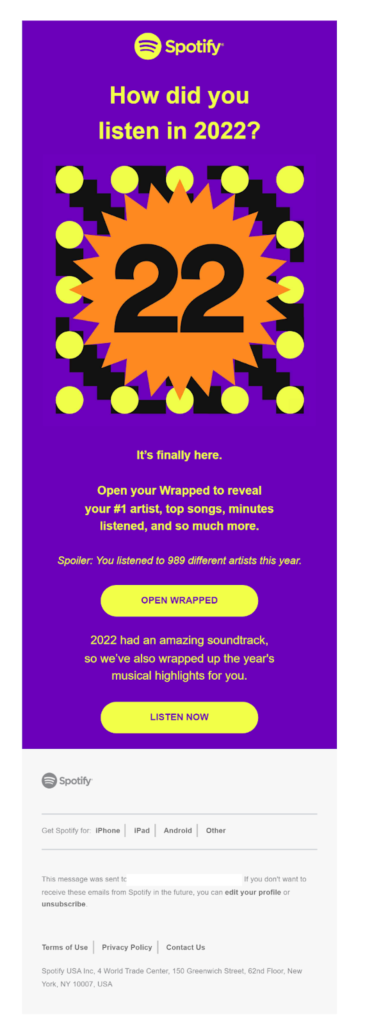
📨 Your 2022 Wrapped has arrived
Weekly, monthly or annual recaps are a useful tool to remind customers to use your app and show them the value it brings. Many of these recaps include use charts, tiered performance scores, or other gamification elements.
Spotify masterfully delivers value and a powerful product reminder to customers with its clickable, shareable end-of-year playlist summary.
This branded presentation, called Wrapped, is something customers have learned to expect from the brand as an added service and reward for their loyalty.
Spotify Wrapped illustrates an interesting way to use your customers’ data to surprise and delight them.
📧 Post-purchase thank you to customers for their community participation: Amazon sends value-adding content along with a thank you to customers who follow an author.
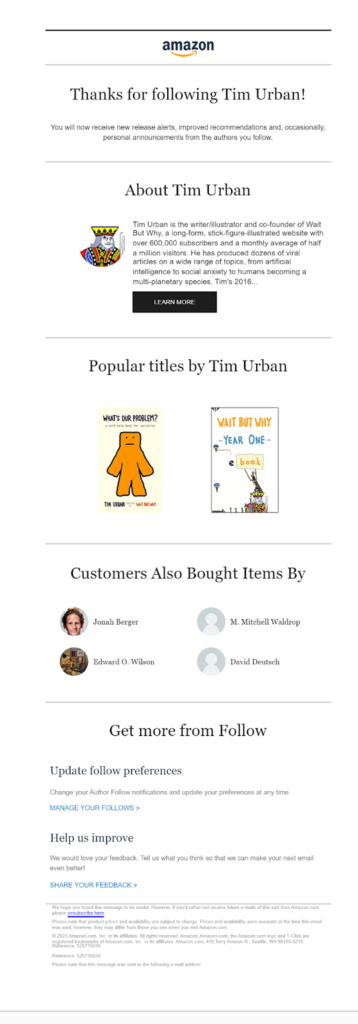
📨 Thanks for following Tim Urban!
Online marketplace Amazon has lots of post-purchase emails in its campaign chest. This community member thank you is just one way the brand stays in touch with customers and promotes sales.
This email isn’t directly promotional, though. Instead, it thanks a new customer for signing up to follow the author of a book they purchased and adds details to help onboard them into the author’s Amazon community.
Along with a thank you, the email’s CTAs invite recipients to learn more, manage their follows, or share their feedback. The message also includes links to the author’s available books and uses a recommendation section to suggest other authors that customers with similar tastes like.
Examples of post-purchase promotions encouraging upsells, cross-sells and repeat purchases
It’s not always easy to categorize an email as one type or another. Often your best campaigns will combine more than one tactic to build sales, loyalty and communicate value. Nonetheless, I’ve made the attempt. The emails in this section add value and offer deals.
📧 An enticing educational email that encourages product use from David’s Tea.
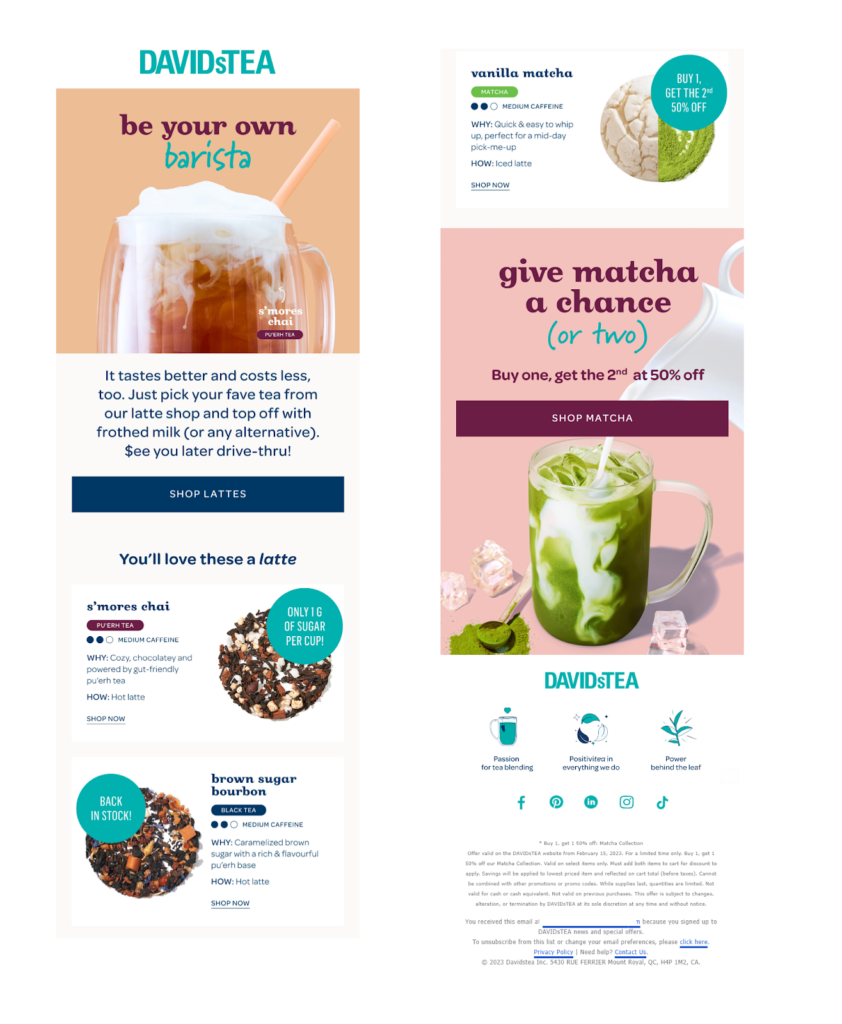
📨 Lattes on a dime – + save 50% on matcha!
David’s Tea encourages repeat purchases with its email newsletters and other campaigns. This opens with an indulgent hero image of a tea latte followed by instructions for how you can make your own using your favorite David’s Tea flavor.
This above-the-fold enticement puts tea on recipients’ minds and presents alternative methods for consuming it–a well-known tactic to encourage more sales. (Remember all those Jello recipes?)
Following the recipe tip, the email introduces three popular tea flavors along with descriptions of their flavor profile, caffeine content, and whether they work best for hot or cold lattes.
Mmm… hot brown sugar bourbon or cold vanilla matcha?
Once a customer reaches the bottom of this email and is contemplating which teas they might like to try, they’re presented with a “buy one, get the second at 50% off” offer.
Like some of the other examples I’ve shared, this email has brand personality and values signals above its footer.
Three clickable graphics with captions present David’s Tea’s, “Passion for tea blending, positivity in everything we do, and power behind the leaf.”
📧 Restock reminders catch customers before they shop somewhere else.
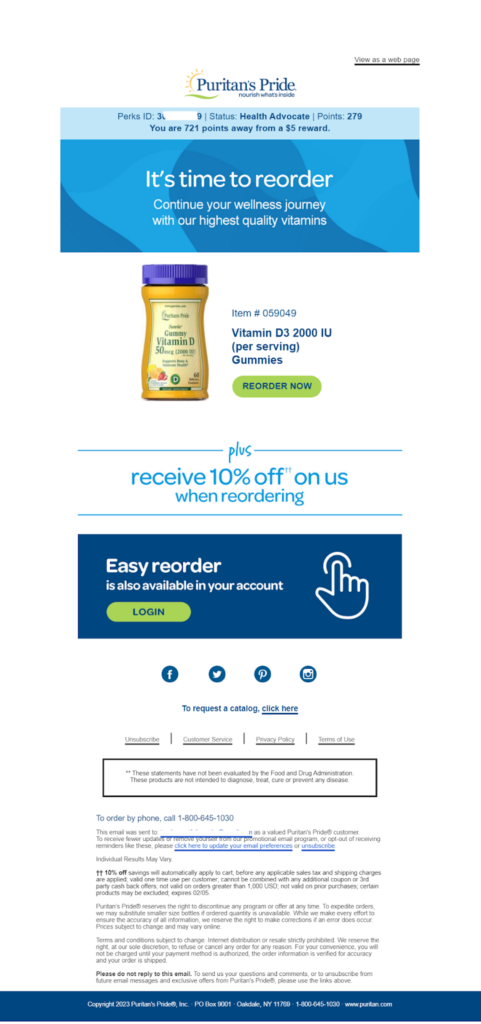
📨 Is it time to reorder? – Your health is our top priority.
This restock reminder from health supplement brand Puritan’s Pride is shorter than its onboarding or other promotional emails–a good reminder that one size does not fit every objective.
Restock messages are designed to trigger a quick decision.
You want your subscribers to think, “Yes, I’m still using this item and I don’t want to run out so I’m going to reorder now.”
Puritan’s Pride makes its restock email’s purpose clear with a header announcing, “It’s time to reorder,” and a large image of the product and its description above a CTA button that says “reorder now.”
A 10% offer offsets the potential that customers will want to shop around. They don’t need to when they can click and go to exactly what they need and save money, right?
What will you add to your email’s copy and design to overcome unspoken objections on our customer’s path to repurchase? Try a discount, VIP perks, star ratings and testimonials, free shipping, or maybe all of these.
📧 Reorder reminder for an annual purchase from H&R Block.
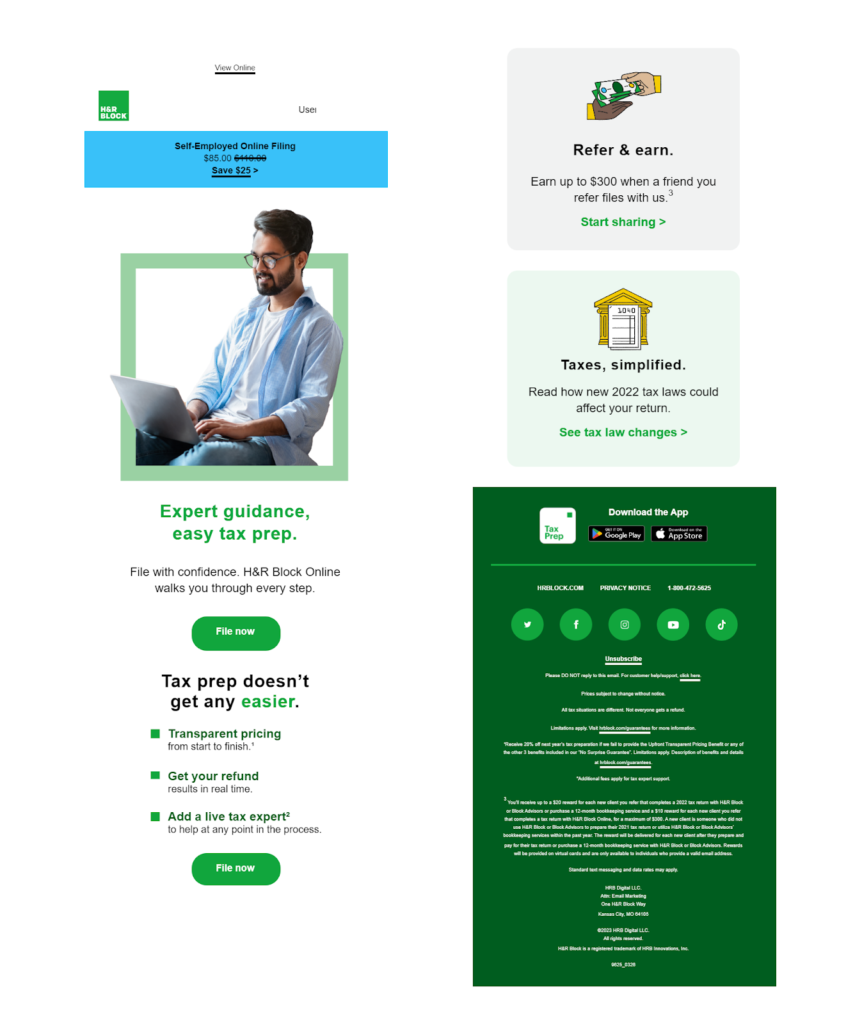
📨 Take $25 off and file with confidence, {{First_Name}}.
When your product is at its most valuable just one time a year, it’s important to get your customers’ attention and remind them of its benefits before it’s too late. H&R Block incentivizes reorders with a discount code and makes purchasing easy with a customized link to each purchaser’s account page.
Personalization isn’t always about greeting someone by name. Businesses use various data sources and types to create relevant, one-of-a-kind emails at scale.
Throughout this email a “file now” button prompts recipients to get started preparing their taxes while the copy explains the benefits of choosing H&R Block. The brand also promotes its referral program in this email–bringing the growth funnel (or is it a french horn📯) full circle.
Above the footer in this template, is a link to educational information explaining the impact 2022’s new tax laws will have on filers.
📧 Bonus points, product recommendations, and a sale to bring customers back for more at Macy’s.
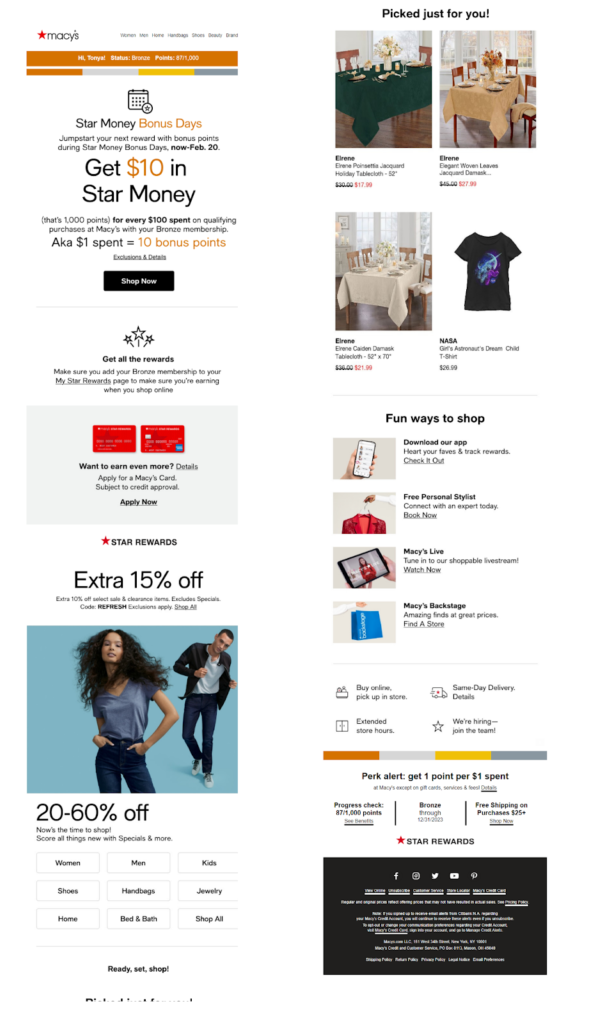
📨 Ready to earn Star Money even faster? ⏰ – Shop Bonus Days & rack up points in no time…
This promotional newsletter sent to Macy’s Star Rewards members includes a mix of standard and personalized content. The message announces a bonus period in which shoppers can get more rewards dollars for each purchase and includes the individual recipient’s current reward points balance.
Rewards dollars can only be spent with the retailer. So these types of offers have a compound impact on sales (if customers come back to cash in their rewards).
The email also leverages another way to boost sales and earn customer loyalty, offering a store credit card. Next, the newsletter promotes the retailer’s current sales. Before segueing into a selection of ways to shop links, the message includes a dynamic block of personalized product recommendations that are based on the customer’s browsing history.
👀 I’ve not included a lot of product recommendation email examples in this article because those emails are so special we gave them their own article! Check out How to Use Product Recommendation Emails to Increase Conversions and Revenue for fresh ideas, examples, and subject lines!
📧 A post-purchase discount notification from No Cow may encourage customers to stock up and save.
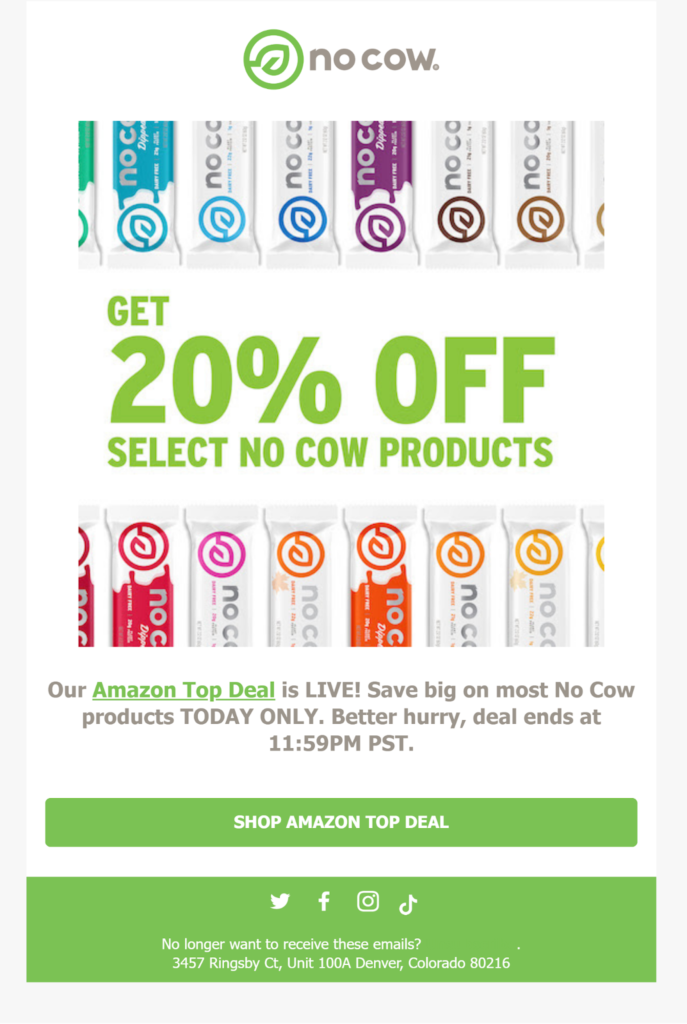
📨 Save big in our Amazon Top Deal! – Better hurry, sale ends today!
Snack bar maker No Cow builds momentum for its sale on Amazon by reaching out to past customers with a heads up about the deal. Not only can offering big savings bring lapsed customers back and encourage fans to stock up, it can also boost sales on the online marketplace which helps the brands visibility.
Examples of post-purchase emails that encourage brand loyalty and advocacy
Brand advocacy can take many forms. The product review request emails I shared earlier can become brand advocacy if your customers have favorable things to say about you. You can also encourage brand loyalty and a sense of belonging by sharing community created content or news.
📧 A message that puts the spotlight on user-generated content: Pattern Brands shows how customers use its products.
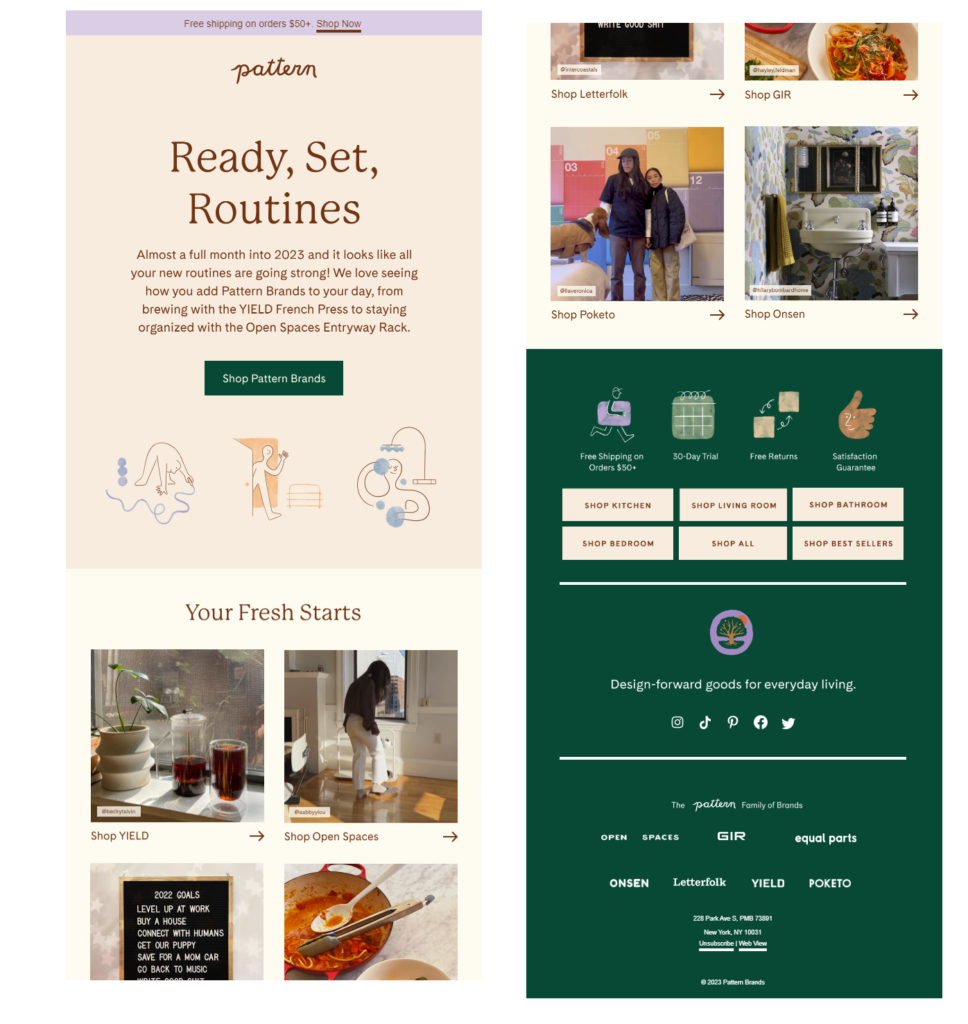
📨 Thanks for sharing your new routines with us – We love seeing you enjoy life
Themes in this nurture campaign include appreciation, setting routines, and community. In this example of an email that invites and shares user-generated content, Pattern Brands writes,
“We love seeing how you add Pattern Brands to your day, from brewing with the YIELD French Press to staying organized with the Open Spaces Entryway Rack.”
After a “Shop Pattern Brands” CTA button, the email features images submitted by customers and tagged with their social media handles using different products. Below each image is a link to the product set.
This template closes with a navigation panel, brand tagline, social media links and links to the “Pattern family of brands,” giving shoppers plenty of ways to discover their next favorite thing.
📧 A post-purchase message inviting brand stickiness and evangelism with a community forum: ProWritingAId encourages users to support one another.
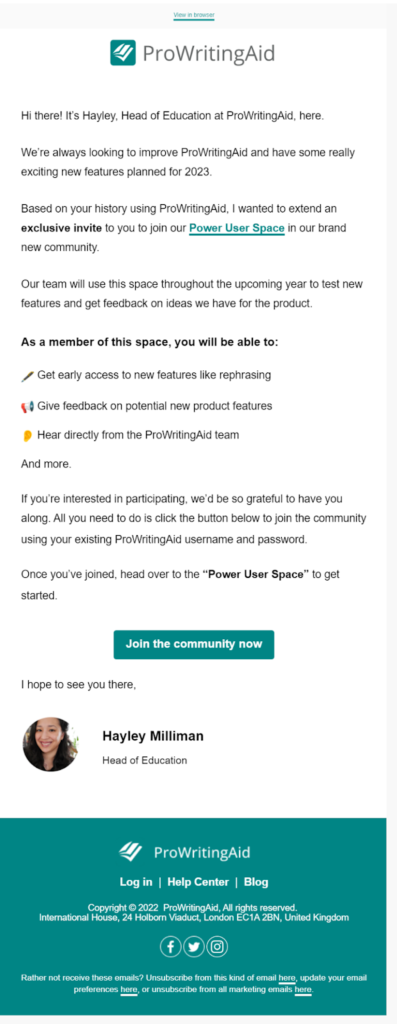
📨 Will you help us improve ProWritingAid? Our exclusive ProWritingAid Power User community.
So many persuasive elements in this post-purchase loyalty builder. There’s asking a favor, plus exclusivity and community.
How does offering this exclusive community benefits the brand?
In my experience, those most likely to be active participants in a brand community are also loyal advocates. Your community members can also take some pressure off your customer service team and increase adoption rates for your products by answering questions and ensuring new users’ success.
Awesome!
This email makes the pitch by sharing the benefits of the community while also emphasizing its exclusive nature and the influence “power users” will have over future product features.
The copy for this email’s CTA urges action, saying “Join community now.”
📧 Inviting customers to share their personal stories: Mad Rabbit Tattoos and its customers bond over ink.
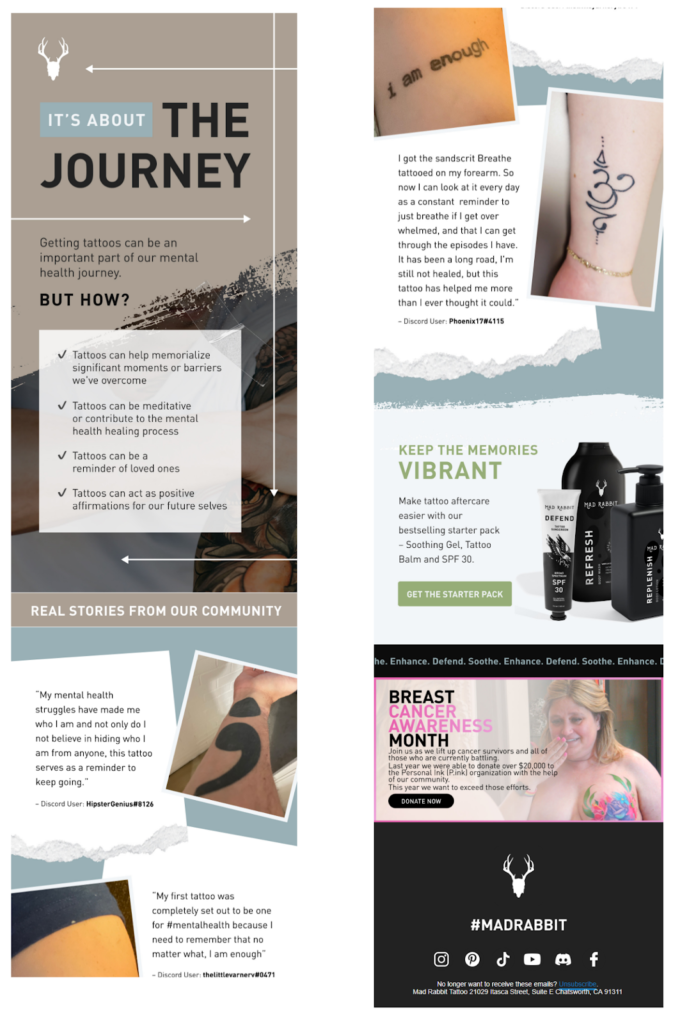
📨 What do your tattoos mean to you? – The power of the ink ➡
Mad Rabbit Tattoos affirms community members’ choices and connects them with supportive testimonials collected from participants on the brand’s Discord channel in this email newsletter and published under the heading, “real stories from our community.”
The email includes a link to Mad Rabbit Tattoos’ tattoo after-care products below the fold. However, the primary focus is on personal well-being. The opening sentence declares,
“Getting tattoos can be an important part of our mental health journey.”
Building a community where your customers can share their experiences and values creates loyalty that extends beyond product and price.
📧 Recruit brand ambassadors with post-purchase emails to your most engaged customers.
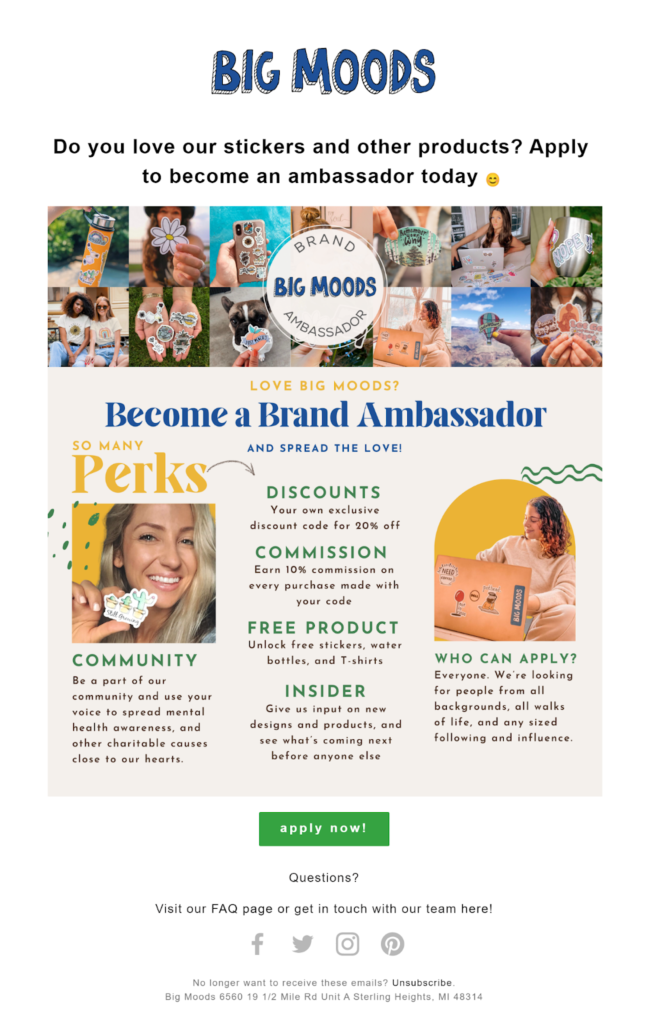
📨 Become a Big Moods ambassador 🙂🌸- We’re officially taking applications!
Finding brand advocates isn’t as easy as identifying brand loyalists. Not every customer will be interested in actively advocating for your brand. Some may limit their support to an occasional personal recommendation or a product review.
A good place to start looking for active fans is your subscription list. Use your customer and subscriber data to identify people who are loyal customers and engaged email recipients. Invite them to join your customer advocacy program. This email from Big Moods puts out the word that the brand is seeking supporters and details the incentives brand ambassadors will get in return.
📧 Send satisfied customers a refer-a-friend email to fuel growth: Zoom offers rewards to users who spread the word.
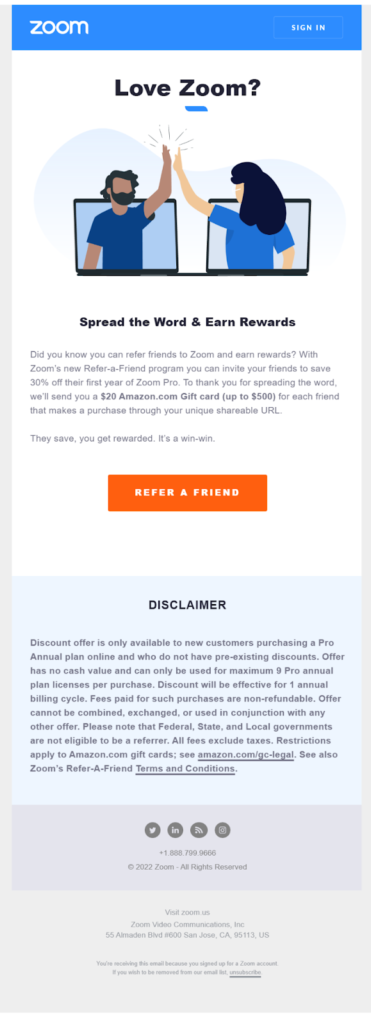
📨 Don’t Zoom Alone – Invite your Friends and Earn Rewards – Give 30%, get a $20 Amazon.com Gift Card
Customer referrals are a great tool for growth because they combine the persuasive powers of a personalized testimonial from the “promoter” (the person making the referral) with an incentive to participate. There’s also a social element to the transaction since these programs are often framed as doing a favor for a friend.
Your referral program doesn’t have to be just a footnote in your regular emails. Go beyond a “refer a friend link” to gain participants.
This email from Zoom doesn’t just reference the video conference tool’s referral program–it’s all about the program.
“Love Zoom?… Spread the word & earn rewards,” announces the header and subheader in this message to users.
Here’s the offer copy:
“With Zoom’s new Refer-a-Friend program you can invite your friends to save 30% off their first year of Zoom Pro. To thank you for spreading the word, we’ll send you a $20 Amazon.com Gift card (up to $500) for each friend that makes a purchase through your unique shareable URL.”
Referral programs are most effective when they offer doubled-sided incentives where both promoter and the person being referred receive a benefit from the transaction.
And, while we think of referral programs as friend-to-friend, referrals may also come from strangers who publicly share their referral code or broadly promote a brand’s products to earn referral rewards.
A cap on total rewards, like the one Zoom includes in its offer, can reduce the chances that your referral program begins to look like affiliate marketing.
Why does the source of a referral matter? Because friend or colleague referrals have an inherent credibility that a recommendation made solely for financial reasons doesn’t.
Post-purchase winback and reactivation email examples
Sometimes customers churn for reasons outside a business’s control. They may move away or transition to another stage in life. Parents stop buying diapers and start buying sports equipment. Former ski bums stop buying winter wear and switch to surf gear. You get the idea.
But other times, reducing attrition is a matter of sending the right message at the right time. Post-purchase winback or reactivation campaigns are the customer version of your subscription re-engagement campaigns.
These winback messages may be distinctly “come back, we miss you” themed or look just like some of the other post-purchase examples I’ve shared. For instance, one strategy to get someone to come back without saying, “we miss you,” is to remind them they have reward bucks to spend.
Here are some examples of winback messages to inspire your next customer recovery campaign.
📧 A post-purchase non-achievement nudge email: CloudApp updates subscribers on their lack of productivity.
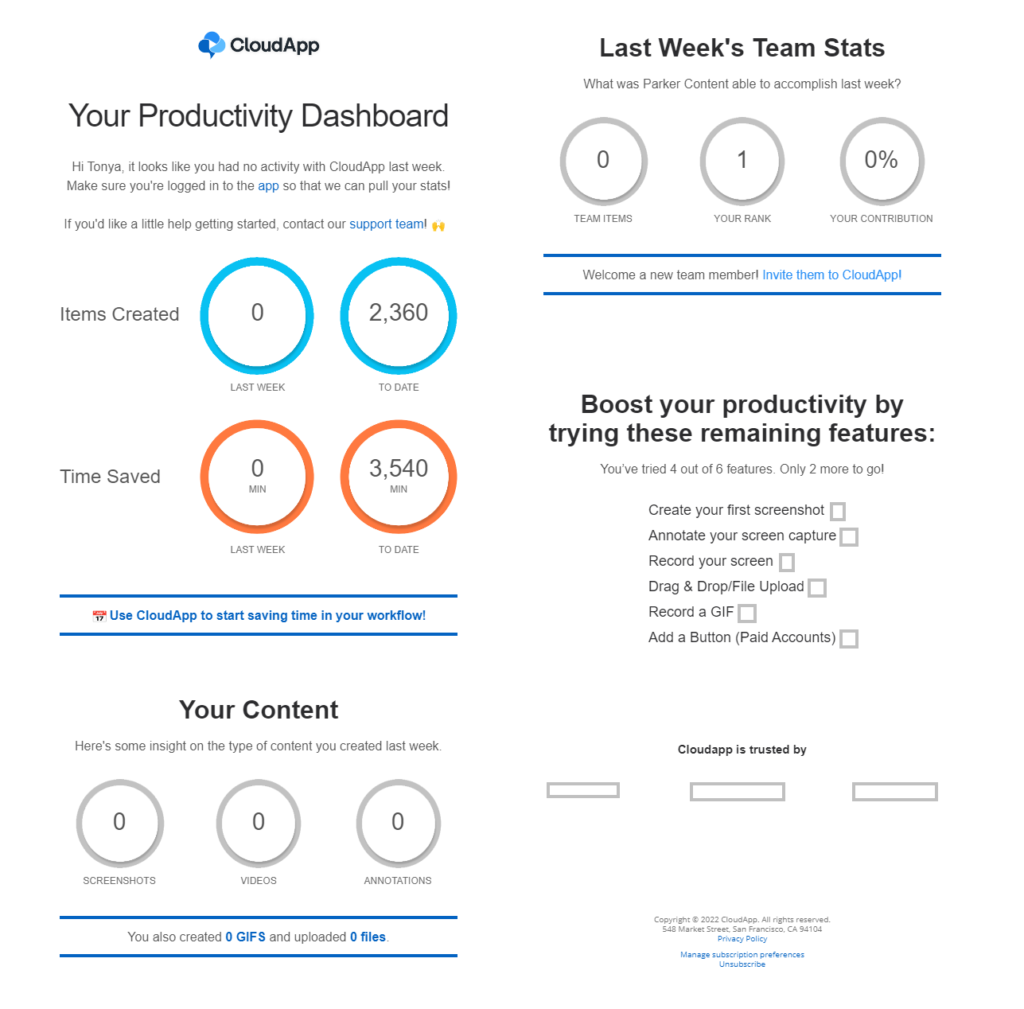
📨 Hmm no screenshots last week? Use CloudApp to save additional time in your workflow. – Your Productivity Dashboard.
Like many apps, the image clipping tool CloudApp moves new customers toward the “Aha!” moment and maintains forward momentum by sending regular productivity updates. These customized messages with dynamic blocks that display dashboard-style performance reports use visual appeals and gamification to communicate the app’s value.
But what if customers aren’t using the app? Sometimes a negative report card is the nudge they need. This email from CloudApp isn’t too critical.
It retargets lapsed users with the same dashboard data the active users receive, accompanied by a different subject line opening paragraphs.
Instead of the regular congratulatory text, this “where ya’ been” message offers assistance,
“Hi {{First_Name}}, it looks like you had no activity with CloudApp last week. Make sure you’re logged into the app so that we can pull your stats! If you’d like a little help getting started, contact our support team! 🙌”
The winback message does a little preemptive troubleshooting (maybe you aren’t logged in) before inviting the recipient to contact support if they need assistance.
Make your message a two-way exchange. Use your lapsed customer reactivation emails to provide solutions, point customers to online resources and contact channels and ask for their feedback to find out where you’ve failed to surprise and delight them.
📧 Reward points reminder email: Moon Cheese reminds customers to come back and spend their earnings.
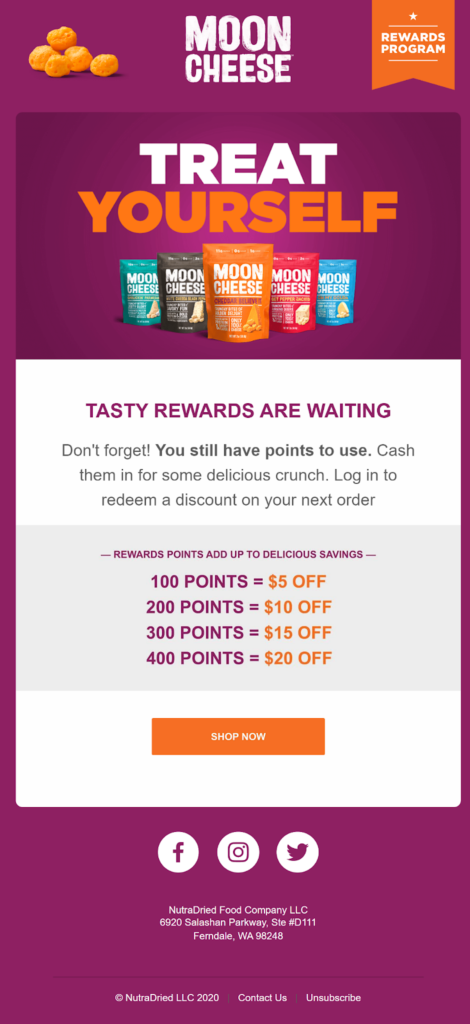
📨 You’ve got Points to Spend – Cash in your points for Moon Cheese before it’s too late.
Combining carrot and stick or greed versus FOMO, this message from Moon Cheese wastes no time in urging customers to come back. The subject line tells the recipient they have rewards points waiting while the preview text adds urgency.
Moon Cheese’s colorful message features product images in the hero section plus a breakdown of the savings customers can redeem at each points level, finished off with a high contrasting color, “shop now” button CTA.
15 tips for writing post-purchase emails that reduce churn and boost revenue
Maximize the returns of your post-purchase email campaigns by following these post-purchase email best practices:
- Make sure you have the appropriate permissions before sending marketing messages to your customers.
- Take a customer-first approach to building relationships that focus on a mutual exchange of value and benefits.
- Create copy and designs that conform to your brand’s style, show its values and humanize your company.
- Integrate your data sources and use personalization along with optimized send times to enhance the relevancy and value of your post-purchase messages.
- Leverage social proof, community sentiment, authority and other persuasive elements to instill confidence in purchasers.
- Don’t overlook the value of non-promotional campaigns in fueling customer loyalty and repeat purchases. Build onboarding and informational sequences that support attraction marketing.
- Remove friction on the path to re-purchase by including customized links to relevant account, order tracking and other pages in your post-purchase messages.
- Maintain a steady cadence of communications. Don’t stop paying attention to your customers after the first sale.
- Use discounts, VIP programs and other rewards strategically to attract and retain high-value customers and protect your ROI.
- Cross-promote your brands, include referral invitations and social media links in your post-purchase emails to expand your reach and the number of channels through which your customers connect with you.
- Listen to your customers and monitor your metrics to continually improve your customers’ post-purchase experience and reduce your churn rates.
- Streamline your post-purchase email marketing by creating templates for your top campaigns.
- Optimize your email templates for accessibility and rendering on mobile devices.
- Run each new campaign or drip sequence through a pre-sending checklist before you add them to your schedule.
- Use A/B testing to select engaging subject lines and preview text and to test other key elements of your post-purchase emails such as your CTAs.
Bonus: 101 post-purchase email subject lines to charm your customers and keep them coming back for more
Every great email click-through and conversion starts with an open. The persuasiveness of your post-purchase emails’ subject lines and preview texts are critical to the success of your customer retention and revenue expansion email marketing plans.
Use these subject line suggestions to earn opens for your post-purchase emails.
Transactional & confirmations
- Thanks for shopping with us! Here’s your order # {{Order_No.}}
- {{First_Name}}, thank you for choosing us! – Your order will ship soon.
- We’re sending something special your way soon!
- Thanks for your order- We’ll send an update when it’s ready to ship.
- Order received! – Your order is being prepared now. We’ll send you an update soon.
- Your [Brand] order confirmation. Thank you for your order!
- Thank you for your order – Here’s what you need to know.
- Thank you for your order – Here’s what happens next.
- Thank you for joining [VIP or reward program] – We’re so glad you’re here!
- Thank you for your order!
- You’re on the list to get…
- Your recurring order charge confirmation
- Your subscription will auto-renew on …
- Thank you for renewing…
- [Business] account creation. – Welcome!
- Your order has shipped
- Something special is arriving soon!
- Important update about your order #{{order id}} [Shipping delay or out of stock notification]
- Your order is on its way!
- We’ve shipped your order
- Get ready for something special! Order #{{order id}} is about to ship. – Your order has shipped…
- Woo hoo! Your order is on its way!
- Hurray! Your order has shipped.
- Good news! Part of your order has shipped
- Hurray! The final part of your order was delivered on {{date and time}}
- Your order arrives today! Order #{{order id}}
- Your order was delivered
- Delivery confirmation
- It’s arrived!
- Your items have arrived from order #{{order id}} – Your shipment was delivered.
Welcome and onboarding (after or with order confirmation)
- Welcome to the [brand] family!
- Welcome to [brand]
- Welcome to a new way to [care for your hair, shop your next car, save money, learn…]
- Registration confirmed – We’ll see you there.
- Need help getting started? Book a 1:1 call with one of our experts
- Your first day with [product]
- Welcome to [product] – Let’s get started!
Nurture informational and promotional
- You’re going to love our new look!
- Say Hi to our latest features!
- Get ready for more [product benefit or features such as flavor, shine, productivity]
- Your market update from [business]
- Here’s the latest news from [business or industry]
- Your year-end recap is ready!
- You’re a power user!
- Who’s behind [brand] – Meet the people who [built product, make our brand possible]
- Thanks for sharing your creations with us
- Show us your style – Join the [brand] community and share your favorite outfits
- Thanks for using …
- Coming soon – Get a sneak peek at…
- Your exclusive VIP sneak peek
- Upgrade your subscription with this limited time offer
- Limited time offer – Reorder your favorites and save during our [season] sale
- This new drop is unbelievable – Only available here
- The latest edit from [influencer, designer, brand]
- You’re invited – Join us for a live reveal of [new product, designs, etc.]
- Your support matters – Give now and your donation will be matched…
- Spilling the tea with [influencer] – Watch our one on one conversation with…
- Giveaway alert! – Order your [bundle or special package] this week and get a free bonus gift
- Nominate your favorite! – Submit your nominee for [community award] before [end date]
- Your support matters to us – Thanks for being a [brand or organization] [customer or donator] in 2022
Recommendations
- Personalized for you – Check out the latest products handpicked just for you
- Product you’ll love
- We thought you might like this
- Use your gift card to bring home one of these best sellers
- We chose these top sellers just for you
- Complete your look with these perfect pieces
- This style edits for you
- Ready to accessorize your {{recent purchase}}? – Check out these top picks
- In the mood for something {{recently purchased color}}? These new arrivals are just right
- {{From_Name}} these new arrivals have your name on them – We picked these pieces just for you
Loyalty and rewards
- You earned it: Here’s your voucher!
- Nice work! Here’s your VIP bonus
- Congratulations! You earned {{reward units}} this month!
- Awesome! You earned {{points}} with your last order.
- Exclusive VIP offer – Look inside to find out what’s in store for our favorite customers
- More rewards are calling
- New! Get {{bonus amount}} rewards points when you shop using your [brand] credit card – Sign up today for bonus savings and rewards
- Here’s your year end rewards summary – Thanks for making us a part of your year!
Reminders and reengagement
- Friendly reminder – Just X days left to activate your account.
- Friendly reminder – Refresh your supply of {{product}} before you run out
- Friendly reminder – Your customer appreciation discount code expires {{date or interval}}
- Heads up! Your {{amount}} in reward bucks are about to expire
- Your achievements last week
- We missed you last week
- Your weekly progress
- No [app activity] this month? – How can we help?
- You’ve got reward bucks – Spend them now and get an extra X% off your entire purchase
- Is it time to reorder?
Feedback
- Customize your email and shopping experience – Choose your preferences.
- Will you help us improve? – Complete this short survey…
- Tell us what you think – Join our survey and shape the future of …
- Tell us how you really feel
- We value your feedback
- Opinions wanted
- Did you love our products?
- Cancellation confirmation – We’d love your feedback.
- Rate and review your recent purchase
- How was your delivery experience?
- {{First_Name}}, We’d like your input – Tell us about your experience with…
- What did you think about {{product}}?
- Love what you bought? Review it! – Share your feedback with other customers.
Build lasting relationships that can withstand the markets’ big bad wolves with post-purchase email campaigns
Keep your subscribers close and your customers closer by implementing data-driven email marketing campaigns that reach your audience at the right moment with the right message.
How will you know if you’re doing it right?
Check out our latest analytics article where we detail the email marketing KPIs that matter most and how to use them to track (and improve) your program’s performance, Email Marketing KPIs and How You Can Use Them to Achieve Excellence.

